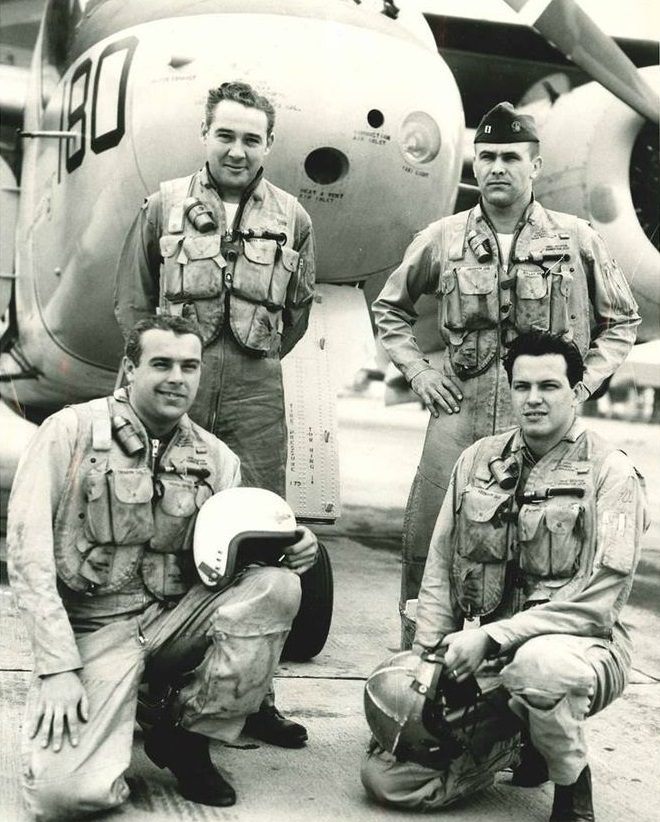1. Early life and education
Donald Rumsfeld's early life and educational experiences laid the groundwork for his extensive career in public service.
1.1. Childhood and family
Donald Henry Rumsfeld was born on July 9, 1932, at St. Luke's Hospital in Chicago, Illinois, to Jeannette Kearsley (née Husted) and George Donald Rumsfeld, a real estate agent. His paternal family had German roots, having emigrated from Weyhe in Lower Saxony in the 1870s, although he was sometimes lightheartedly teased about looking like a "tough Swiss." Growing up in Winnetka, Illinois, Rumsfeld exhibited a natural charisma and a strong work ethic from a young age. As a teenager, he held over 20 part-time jobs, ranging from newspaper delivery to gardening. He became an Eagle Scout in 1949 and was later honored with both the Distinguished Eagle Scout Award in 1976 and the Silver Buffalo Award in 2006 by the Boy Scouts of America. His family attended a Congregational church. From 1943 to 1945, Rumsfeld lived in Coronado, California, while his father was stationed on an aircraft carrier in the Pacific during World War II. This period instilled in him an early interest in politics and world affairs. In 1949, he also served as a ranger at Philmont Scout Ranch. Rumsfeld married Joyce P. Pierson on December 27, 1954, and they had three children, six grandchildren, and one great-grandchild.
1.2. Education
Rumsfeld attended Baker Demonstration School before graduating from New Trier High School, where he excelled academically and in sports, playing drums and saxophone in the band. He attended Princeton University on partial academic and NROTC scholarships. He graduated in 1954 with a Bachelor of Arts in politics, completing a senior thesis titled "The Steel Seizure Case of 1952 and Its Effects on Presidential Powers." While at Princeton, he was an accomplished amateur wrestler, captaining the varsity wrestling team, and also captained the Lightweight Football team as a defensive back. During his time at Princeton, he became friends with Frank Carlucci, who would also later serve as Secretary of Defense. Although Rumsfeld attended Case Western Reserve University School of Law and the Georgetown University Law Center, he did not complete a degree from either institution.
2. Early political career (1962-1975)
Rumsfeld's political career began in the early 1960s, quickly ascending through Congress and into various executive branch positions.
2.1. Member of Congress
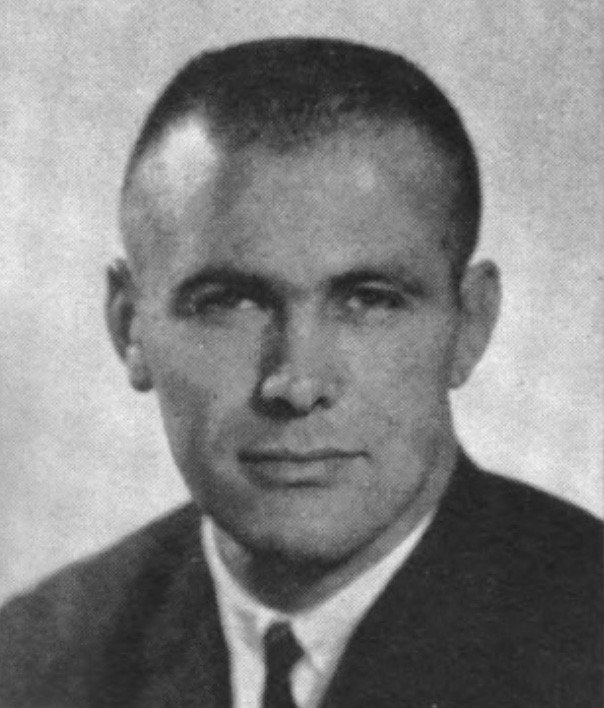
In 1957, during the Dwight D. Eisenhower administration, Rumsfeld served as administrative assistant to David S. Dennison Jr., a Congressman from Ohio. In 1959, he moved to become a staff assistant to Congressman Robert P. Griffin of Michigan. After a two-year period with the investment banking firm A. G. Becker & Co. from 1960 to 1962, Rumsfeld set his sights on a seat in the United States Congress.
He was elected to the United States House of Representatives for Illinois's 13th congressional district in 1962 at the age of 30, and was re-elected by large majorities in 1964, 1966, and 1968. During his time in Congress, he served on the Joint Economic Committee, the Committee on Science and Aeronautics, and the Government Operations Committee, as well as on the Subcommittees on Military and Foreign Operations. He was a co-founder of the Japanese-American Inter-Parliamentary Council and a leading co-sponsor of the Freedom of Information Act.
In 1965, following the Republican Party's significant losses in the 1964 presidential election, Rumsfeld and other young Republicans, known as the "Young Turks", successfully urged Gerald Ford to run for and ultimately replace Charles A. Halleck as the House Republican leader.
As a young Congressman, Rumsfeld voiced concerns about U.S. involvement in the Vietnam War, believing that the Johnson administration was overconfident. A fact-finding mission to Vietnam led him to conclude that the South Vietnamese government was overly reliant on the U.S. He was also dissatisfied with a briefing from General William Westmoreland, commander of U.S. troops in Vietnam. Rumsfeld co-sponsored a resolution to debate the war's conduct on the House floor, but it was blocked by the Democratic majority under pressure from the Johnson administration.
He attended seminars at the University of Chicago, where he was introduced to the concept of an all-volunteer military and the ideas of economist Milton Friedman and the Chicago School of Economics. He later participated in Friedman's PBS series Free to Choose. During his congressional tenure, Rumsfeld voted in favor of the Civil Rights Act of 1964 and Civil Rights Act of 1968, as well as the Voting Rights Act of 1965.
2.2. Nixon Administration
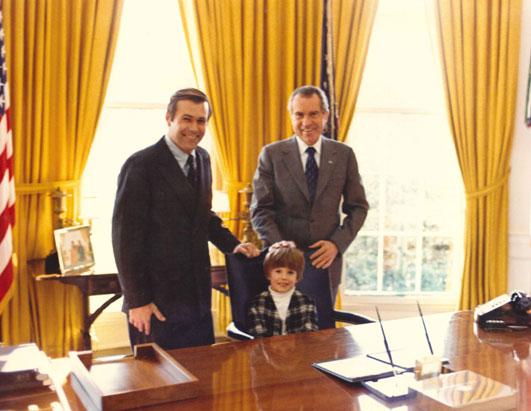
Rumsfeld resigned from Congress in 1969 to serve in the Richard Nixon administration. Nixon appointed him Director of the United States Office of Economic Opportunity (OEO), a position with Cabinet rank. Despite having voted against the creation of the OEO in Congress and initially rejecting Nixon's offer due to his belief that the agency did more harm than good, Rumsfeld accepted after assurances from Nixon that he would also serve as an assistant to the President with Cabinet-level status and an office in the White House.
As OEO director, Rumsfeld aimed to reorganize the office as "a laboratory for experimental programs." He reallocated funds from less successful government programs to save beneficial anti-poverty programs. During this period, he hired his future colleagues Frank Carlucci and Dick Cheney to work under him. Rumsfeld faced an allegation by columnist Jack Anderson that he had cut programs for the poor while spending excessively on office redecoration. Rumsfeld issued a four-page response, calling the accusations false and inviting Anderson to tour his office. Though Anderson did not retract his claims immediately, he later admitted his column was a mistake.
In December 1970, Nixon named Rumsfeld Counselor to the President, a general advisory role with Cabinet status. He regularly interacted with the Nixon administration hierarchy from his West Wing office. He also became director of the Economic Stabilization Program in 1970 and later headed the Cost of Living Council. In March 1971, Nixon was recorded commenting on Rumsfeld: "at least Rummy is tough enough" and "He's a ruthless little bastard. You can be sure of that."
In February 1973, Rumsfeld left Washington to serve as U.S. Ambassador to the North Atlantic Treaty Organization (NATO) in Brussels, Belgium. He was the United States' Permanent Representative to the North Atlantic Council, the Defense Planning Committee, and the Nuclear Planning Group. In this capacity, he represented the U.S. in military and diplomatic matters and was asked to help mediate a conflict between Cyprus and Turkey.
2.3. Ford Administration
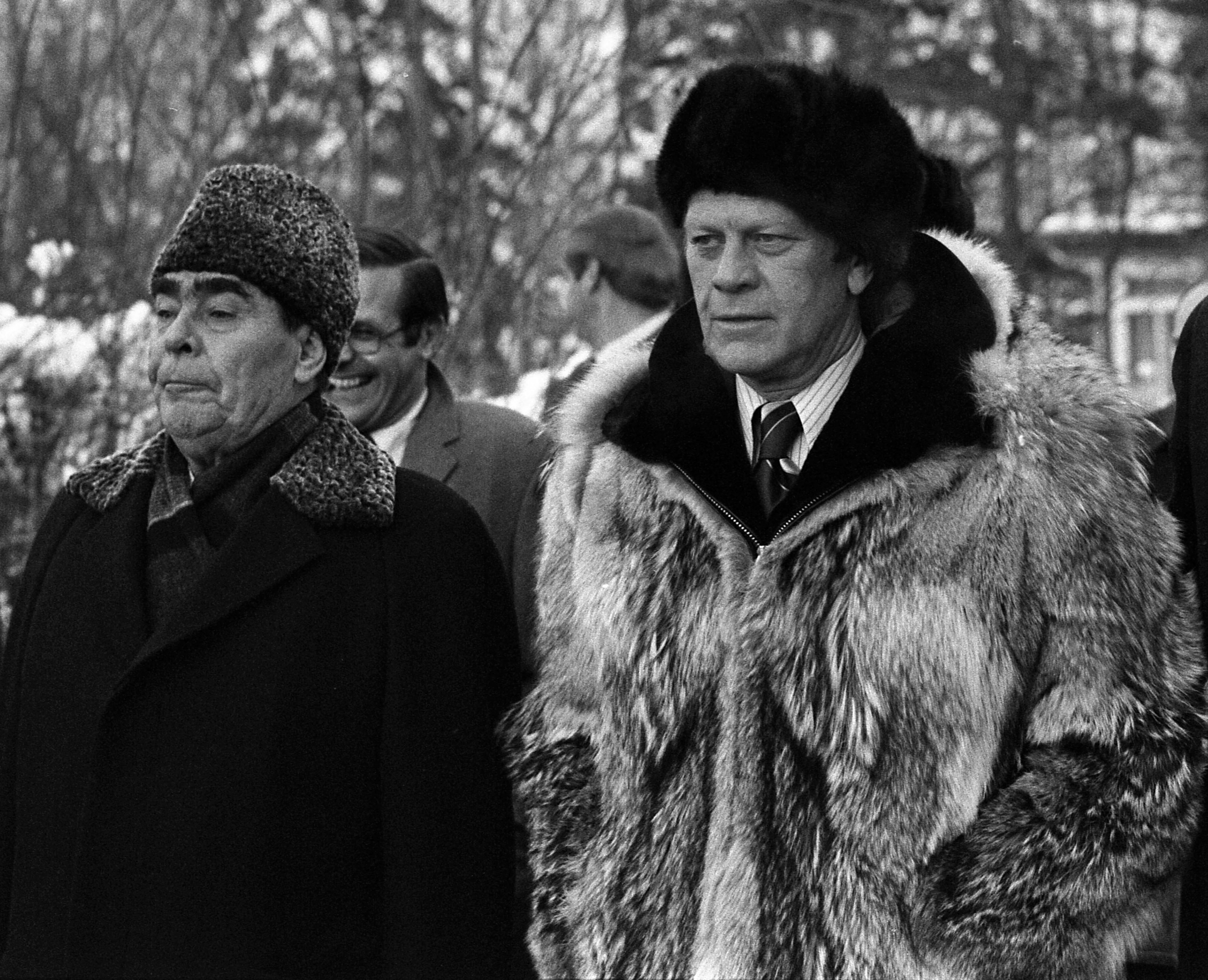
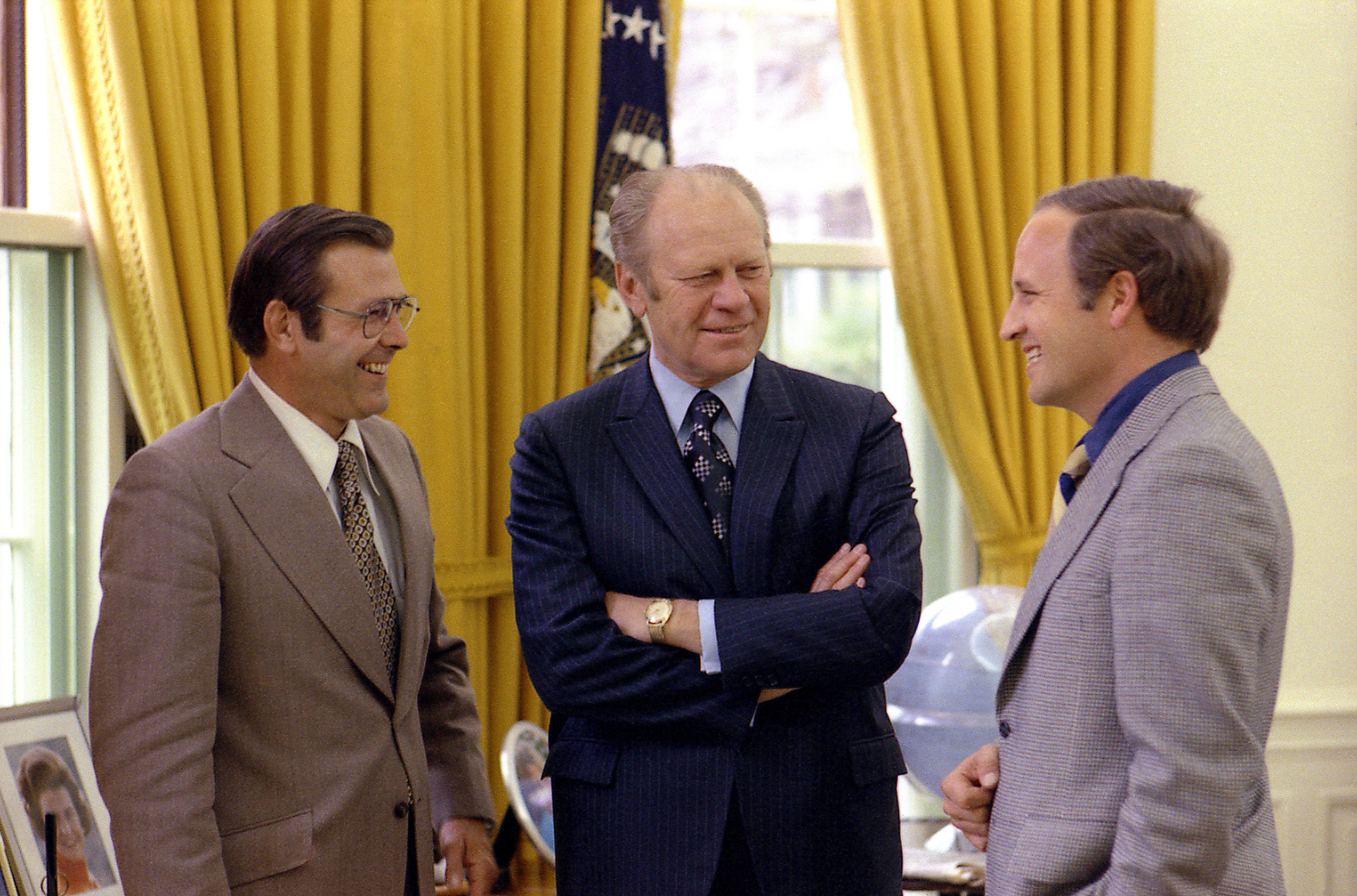
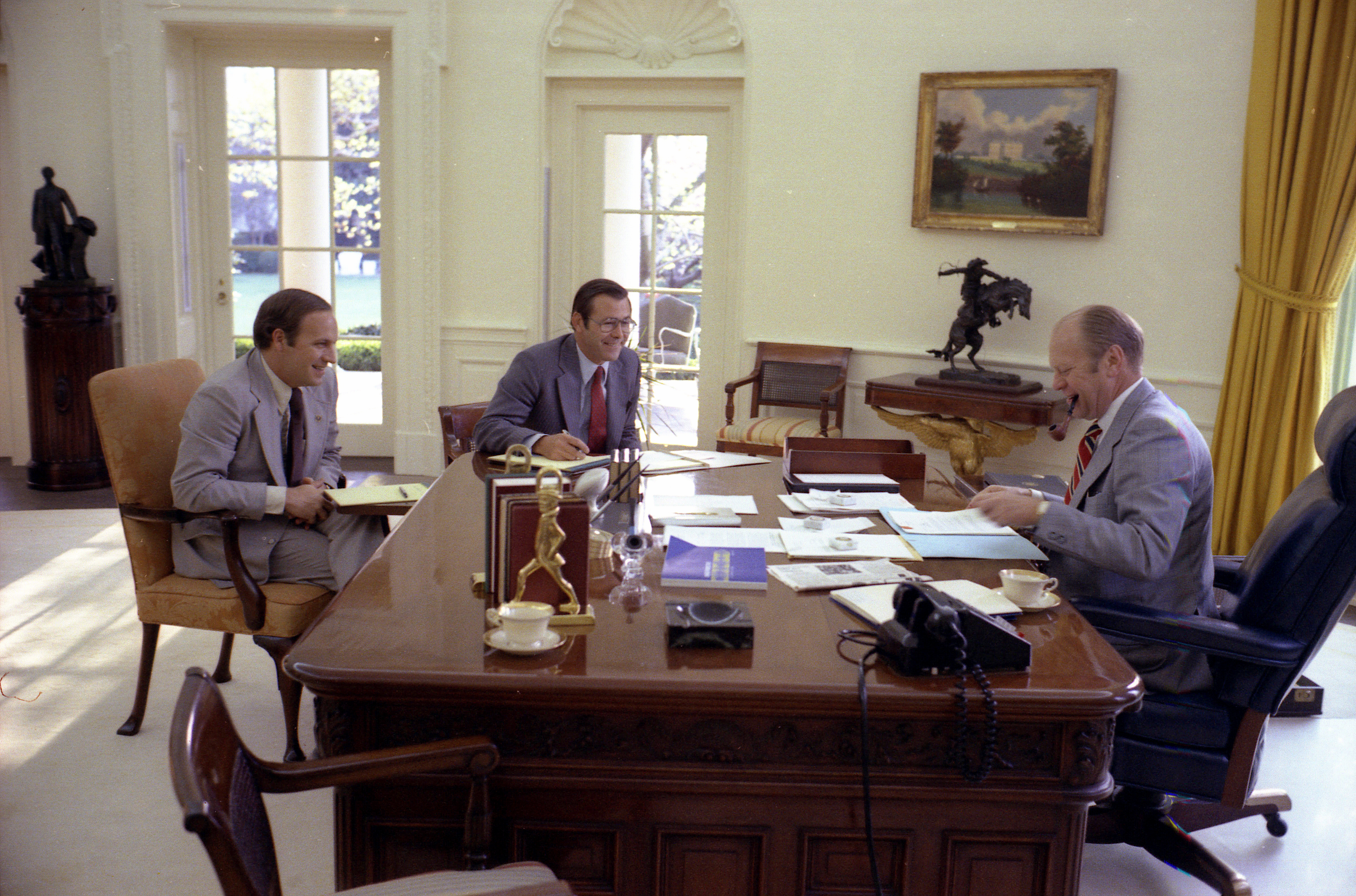
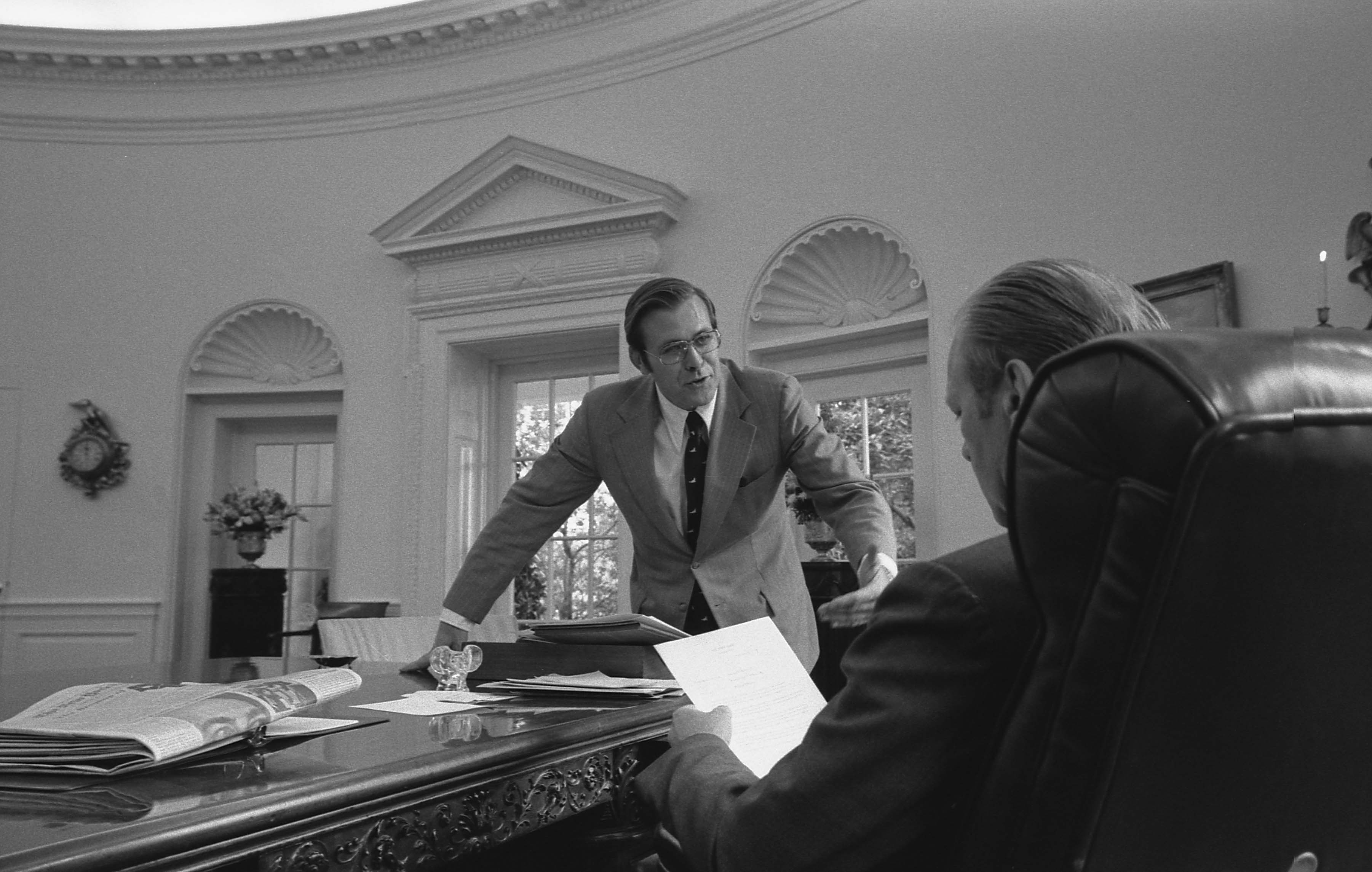
In August 1974, after President Nixon resigned in the aftermath of the Watergate scandal, Rumsfeld was called back to Washington by the new president, Gerald Ford. Having been Ford's confidante since their time in the House of Representatives and a key figure in the "Young Turks" who helped Ford achieve Republican leadership, Rumsfeld was appointed as the transition chairman for the new administration. Following General Alexander Haig's appointment as the new Supreme Allied Commander Europe, Ford appointed Rumsfeld as White House Chief of Staff, a position he held from 1974 to 1975.
3. First term as Secretary of Defense (1975-1977)
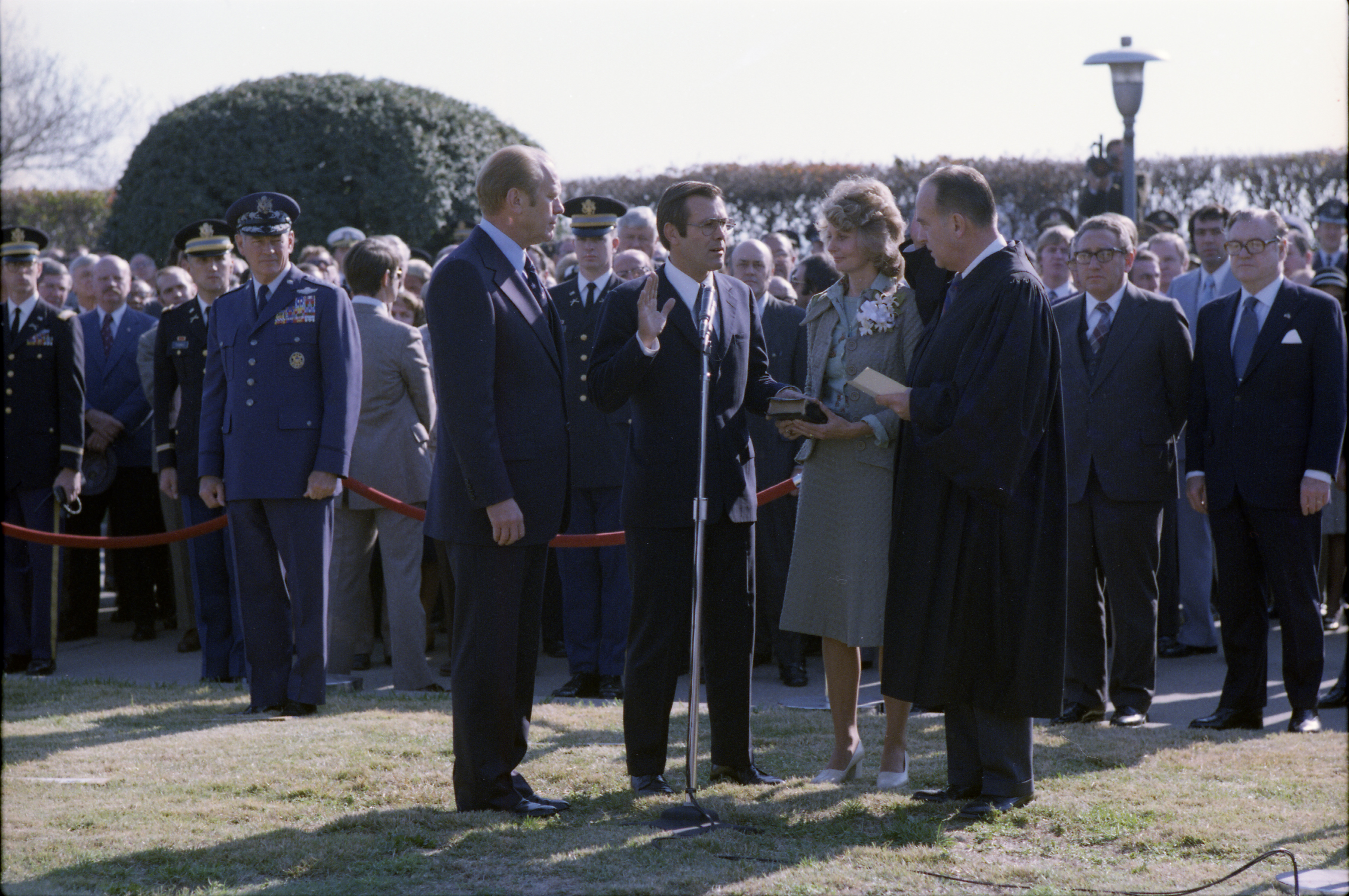
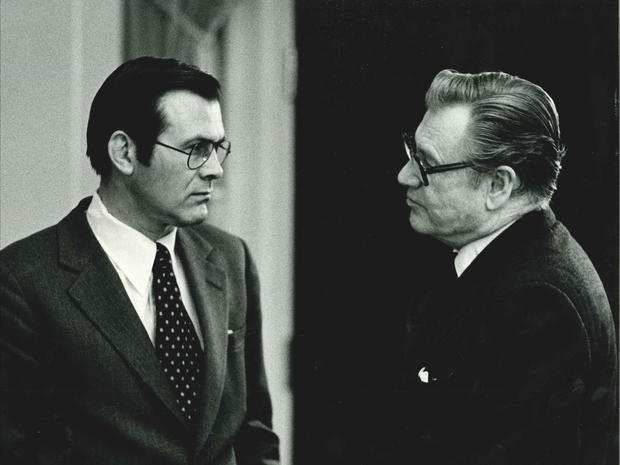
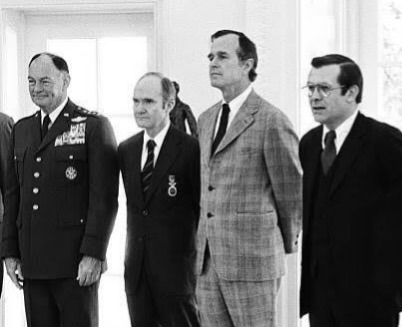
In October 1975, during what was termed the "Halloween Massacre" where President Ford reshuffled his cabinet, Rumsfeld was widely seen as having orchestrated these events. Ford nominated Rumsfeld to succeed James Schlesinger as the 13th U.S. Secretary of Defense, while George H. W. Bush was appointed Director of Central Intelligence. According to later accounts, a rivalry developed between Rumsfeld and Bush, with Bush believing Rumsfeld was pushing him out to the CIA to end his political career.
Rumsfeld's confirmation hearing began on November 12, 1975. He primarily addressed defense policy concerning the Cold War, asserting that the Soviet Union posed a "clear and present danger," particularly after the Vietnam War, which he viewed as an opportunity for Soviet expansion. On November 17, 1975, Rumsfeld was confirmed by a vote of 97-2. At 43 years old, he became the youngest person to serve as U.S. Secretary of Defense at that time.
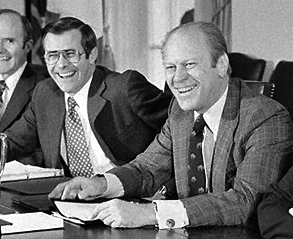
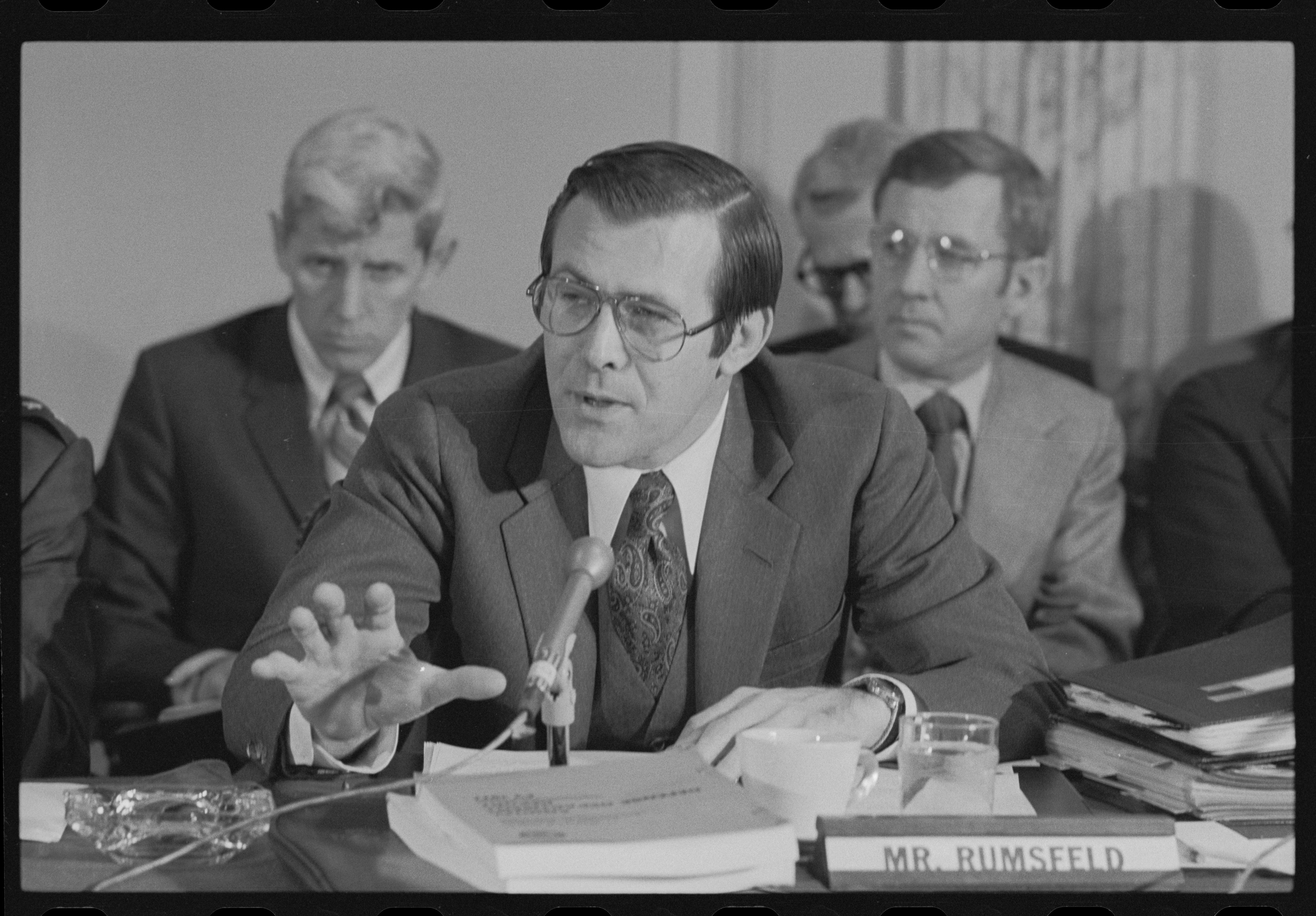
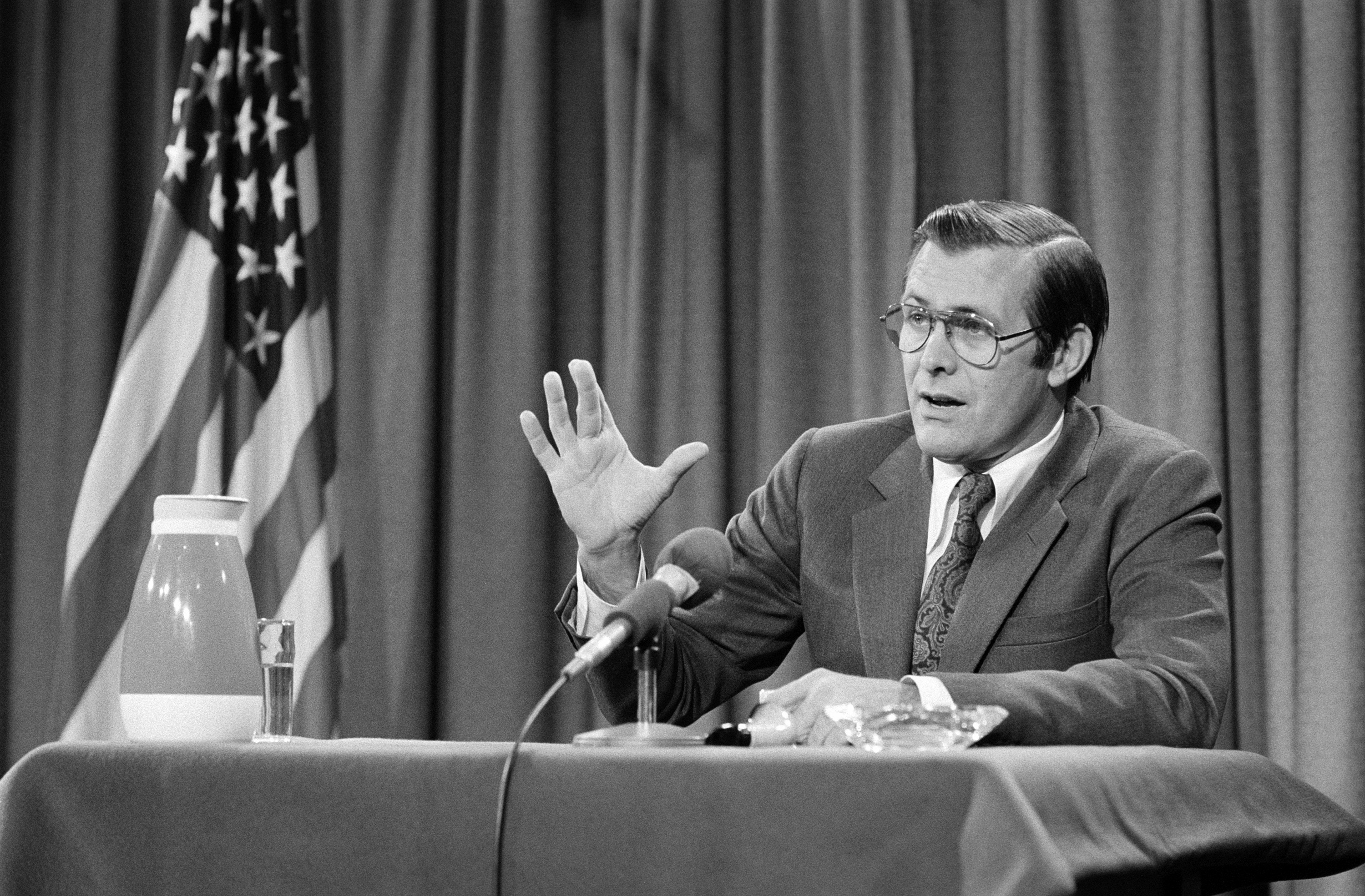
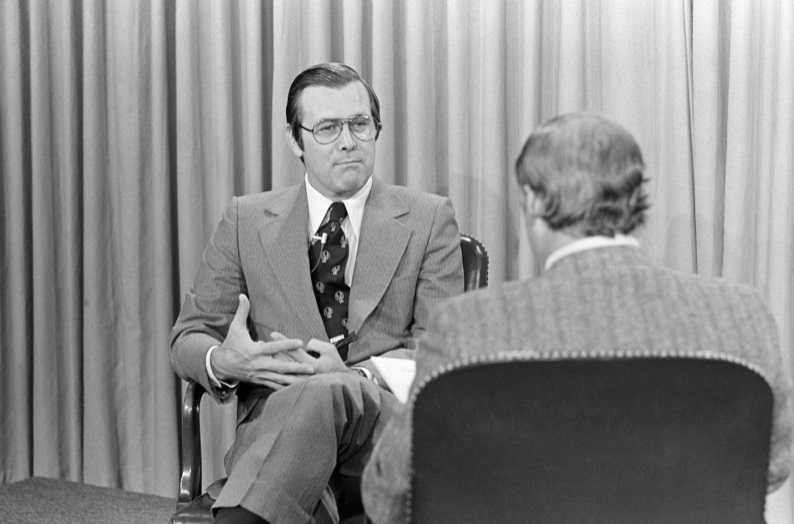
3.1. Key policies and initiatives
During his tenure, Rumsfeld oversaw the transition to an all-volunteer military. He aimed to reverse a decline in the defense budget and bolster U.S. strategic and conventional forces. He asserted, along with Team B (which he helped establish), that military strength trends had not favored the United States for 15 to 20 years and that continued imbalance "would have the effect of injecting a fundamental instability in the world." To address this, he oversaw the development of cruise missiles, the B-1 bomber, and a significant naval shipbuilding program.
At the Pentagon, Rumsfeld implemented structural changes, including appointing a second Deputy Secretary of Defense and combining certain offices. He frequently traveled both domestically and internationally, acting as a key representative for the Defense Department, focusing on the political aspects of his role to secure budget increases and maintain strategic parity with the Soviet Union.
Having previously served on the House Committee on Science and Astronautics, Rumsfeld emphasized the importance of the space program's next phase after the 1969 Moon landing. As Secretary of Defense, he fostered joint cooperation between the Defense Department and NASA to develop Skylab and supported the Space Shuttle program.
3.2. SALT II Treaty
During his time as Secretary of Defense, Rumsfeld was involved in efforts to finalize the Strategic Arms Limitation Treaty (SALT II). He collaborated with Chairman of the Joint Chiefs of Staff General George S. Brown in drafting the treaty. However, an agreement was not reached before the 1976 election and the treaty was ultimately signed during the Jimmy Carter administration.
In 1977, Rumsfeld was awarded the Presidential Medal of Freedom, the nation's highest civilian award. His bureaucratic adversary, Secretary of State Henry Kissinger, later described him as "a special Washington phenomenon: the skilled full-time politician-bureaucrat in whom ambition, ability, and substance fuse seamlessly."
Rumsfeld's first term as Secretary of Defense concluded on January 20, 1977, and he was succeeded by former Secretary of the Air Force, Harold Brown.
4. Return to private sector (1977-2000)
Following his first term as Secretary of Defense, Donald Rumsfeld transitioned back to the private sector while maintaining various part-time public service roles.
4.1. Business career
In early 1977, Rumsfeld briefly lectured at Princeton's Woodrow Wilson School and Northwestern's Kellogg School of Management. He then shifted his focus to business, serving as chief executive officer, president, and later chairman of G. D. Searle & Company, a worldwide pharmaceutical company based in Skokie, Illinois, from 1977 to 1985. Under his leadership, Searle underwent a financial turnaround, earning him awards as the Outstanding Chief Executive Officer in the Pharmaceutical Industry from The Wall Street Transcript (1980) and Financial World (1981). However, journalist Andrew Cockburn alleged that Rumsfeld suppressed information about the potential dangers of Searle's key product, aspartame, by leveraging his old government contacts at the FDA. In 1985, Searle was sold to the Monsanto Company.
From 1990 to 1993, Rumsfeld served as chairman and chief executive officer of General Instrument. This company was a leader in broadband transmission, distribution, and access control technologies for cable, satellite, and terrestrial broadcasting, and it pioneered the development of the first all-digital high-definition television (HDTV) technology. After taking the company public and restoring its profitability, Rumsfeld returned to private business in late 1993.
From January 1997 until his swearing-in as the 21st Secretary of Defense in January 2001, Rumsfeld served as chairman of Gilead Sciences, Inc.. Gilead is known for developing Tamiflu (Oseltamivir), which is used to treat bird flu, as well as influenza A and influenza B in humans. Rumsfeld's holdings in the company significantly increased during his later term as Secretary of Defense, when avian flu became a public concern. He stated that he recused himself from any decisions involving Gilead and instructed the Pentagon's general counsel to provide guidelines on his involvement in the event of an avian flu pandemic that required a Pentagon response.
4.2. Part-time public service
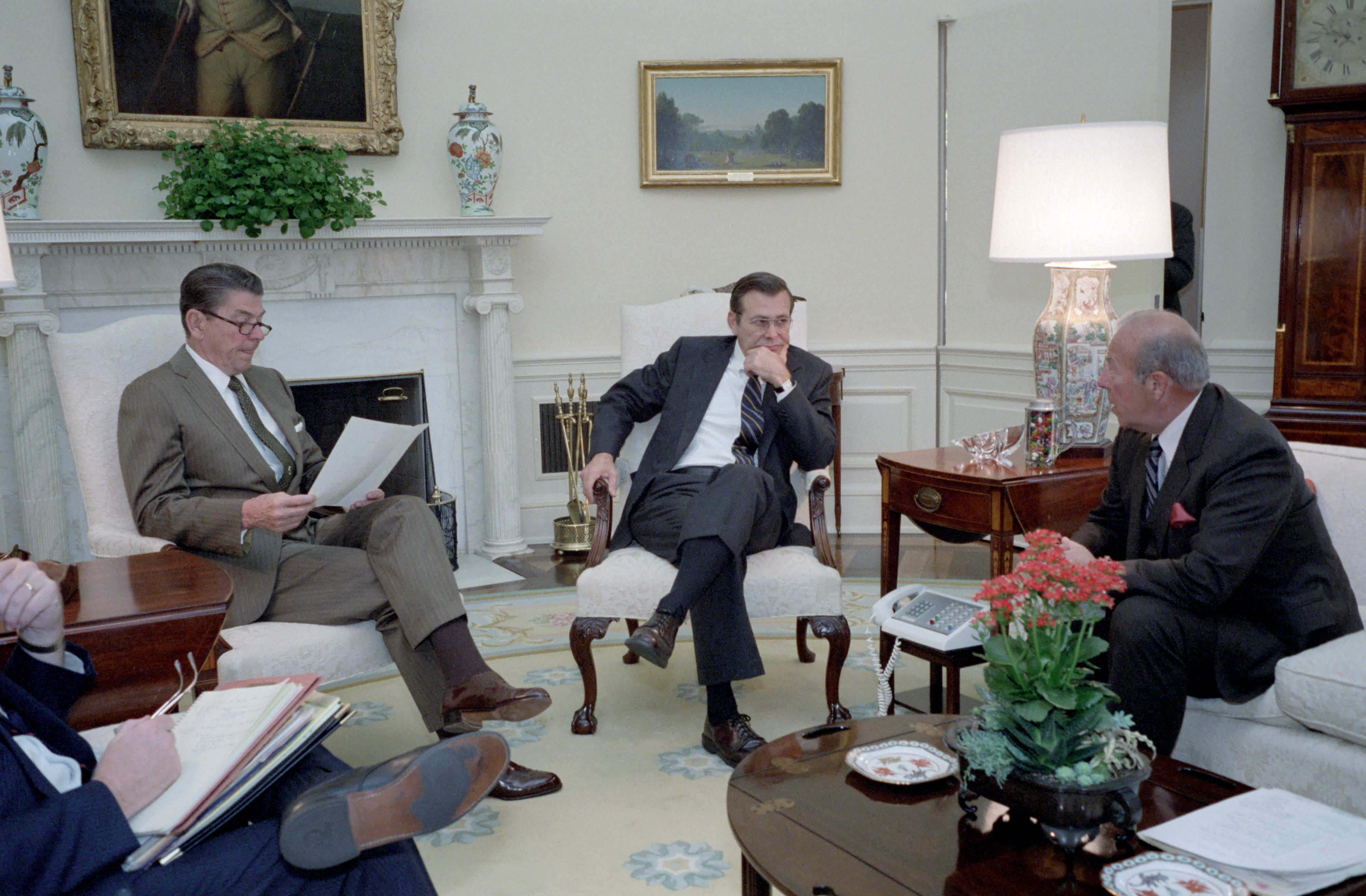
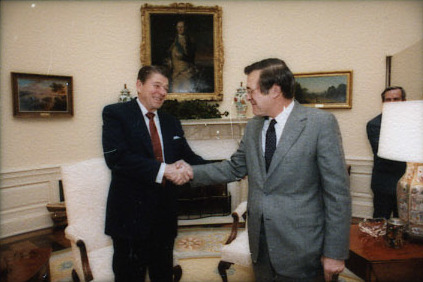
Throughout his business career, Rumsfeld continued to engage in part-time public service. In November 1983, President Ronald Reagan appointed Rumsfeld as his special envoy to the Middle East during the turbulent Iran-Iraq War, with the U.S. favoring Iraq. Rumsfeld was sent to mediate on behalf of the president.
During his visit to Baghdad on December 20, 1983, Rumsfeld met with Saddam Hussein at his palace for a 90-minute discussion. They largely agreed on opposing Syria's occupation of Lebanon, preventing Syrian and Iranian expansion, and halting arms sales to Iran. Rumsfeld suggested that improved U.S.-Iraq relations could lead to U.S. support for a new oil pipeline across Jordan, which Iraq had previously opposed but was now willing to reconsider. Rumsfeld also informed Iraqi Deputy Prime Minister and Foreign Minister Tariq Aziz that U.S. efforts were "inhibited by certain things that made it difficult," citing the use of chemical weapons by Iraq. In his memoir Known and Unknown, Rumsfeld stated that his meeting with Hussein "has been the subject of gossip, rumors, and crackpot conspiracy theories... Supposedly I had been sent to see Saddam by President Reagan either to negotiate a secret oil deal, to help arm Iraq, or to make Iraq an American client state. The truth is that our encounter was more straightforward and less dramatic." The Washington Post reported that although Rumsfeld was not an architect of the Reagan administration's "tilt toward Iraq," his visits led to closer U.S.-Iraqi cooperation on various fronts.
Rumsfeld held numerous other public service roles, including: a member of the President's General Advisory Committee on Arms Control (1982-1986); President Reagan's special envoy on the Law of the Sea Treaty (1982-1983); a senior adviser to President Reagan's Panel on Strategic Systems (1983-1984); a member of the Joint Advisory Commission on U.S./Japan Relations (1983-1984); a member of the National Commission on the Public Service (1987-1990); a member of the National Economic Commission (1988-1989); a member of the board of visitors of the National Defense University (1988-1992); a member of the FCC's High Definition Television Advisory Committee (1992-1993); a member of the U.S. Trade Deficit Review Commission (1999-2000); and chairman of the U.S. Commission to Assess National Security Space Management and Organization (2000).
Among his most notable positions was chairman of the nine-member Commission to Assess the Ballistic Missile Threat to the United States from January to July 1998. The commission concluded that Iraq, Iran, and North Korea could develop intercontinental ballistic missile capabilities within five to ten years, and that U.S. intelligence would have little warning before such systems were deployed.
During the 1980s, Rumsfeld became a member of the National Academy of Public Administration and served on the boards of trustees of the Gerald R. Ford Foundation, the Eisenhower Exchange Fellowships, the Hoover Institution at Stanford University, and the National Park Foundation. He was also a member of the U.S./Russia Business Forum and chairman of the Congressional Leadership's National Security Advisory Group. Rumsfeld was a member of the Project for the New American Century, a think-tank dedicated to maintaining U.S. primacy. From 1990 to 1993, he served as a foreign policy consultant for the U.S. State Department. Although considered a staunch hard-liner against North Korea within the Bush administration, Rumsfeld served on the board of the European engineering giant ABB from 1990 to 2001. ABB sold two light-water nuclear reactors to the Korean Peninsula Energy Development Organization for installation in North Korea, as part of the 1994 agreed framework reached under President Bill Clinton. Rumsfeld's office stated that he did not "recall it being brought before the board at any time," though Fortune magazine reported that "board members were informed about this project." The Bush administration frequently criticized the 1994 agreement and the Clinton presidency for being lenient toward North Korea, later designating North Korea as a state sponsor of terrorism and part of the Axis-of-Evil.
4.3. Presidential and vice-presidential aspirations
During the 1976 Republican National Convention, Rumsfeld received one vote for Vice President of the United States, despite not actively seeking the office. The nomination ultimately went to Ford's preferred choice, Senator Bob Dole. He again received one vote for vice president during the 1980 Republican National Convention.
Rumsfeld briefly sought the presidential nomination in 1988, but withdrew from the race before the primaries began. In the 1996 election season, he initially formed a presidential exploratory committee but decided against a formal entry into the race. Instead, he was named national chairman for Republican nominee Bob Dole's campaign.
5. Second term as Secretary of Defense (2001-2006)
Rumsfeld's second tenure as Secretary of Defense under President George W. Bush (2001-2006) proved pivotal and turbulent, shaping the United States military into the 21st century. Following the September 11 attacks, Rumsfeld was instrumental in planning and executing the United States invasion of Afghanistan and the subsequent 2003 invasion of Iraq, advocating for small, agile forces, a concept known as the Rumsfeld Doctrine. This period was marked by significant influence and considerable controversy.
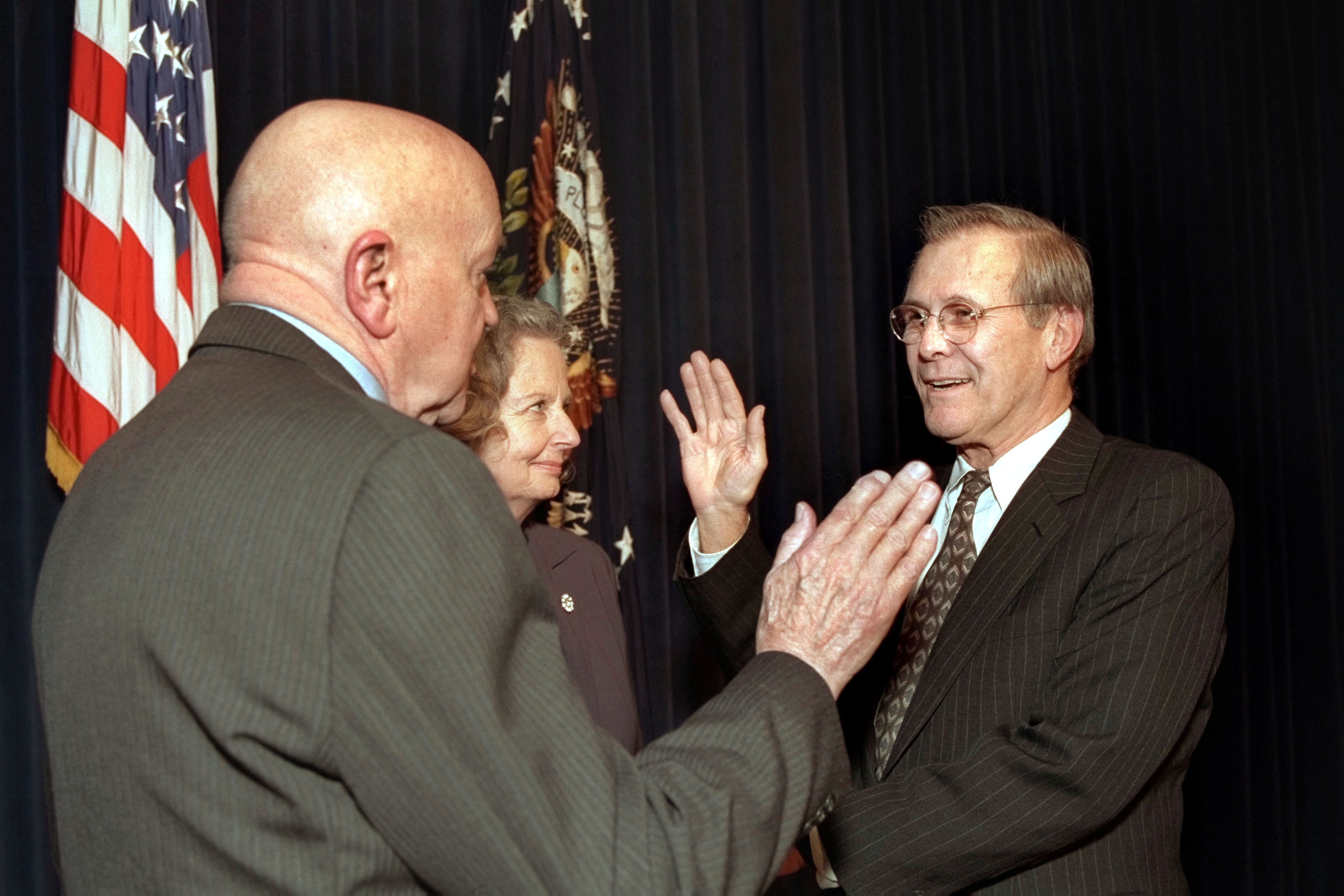
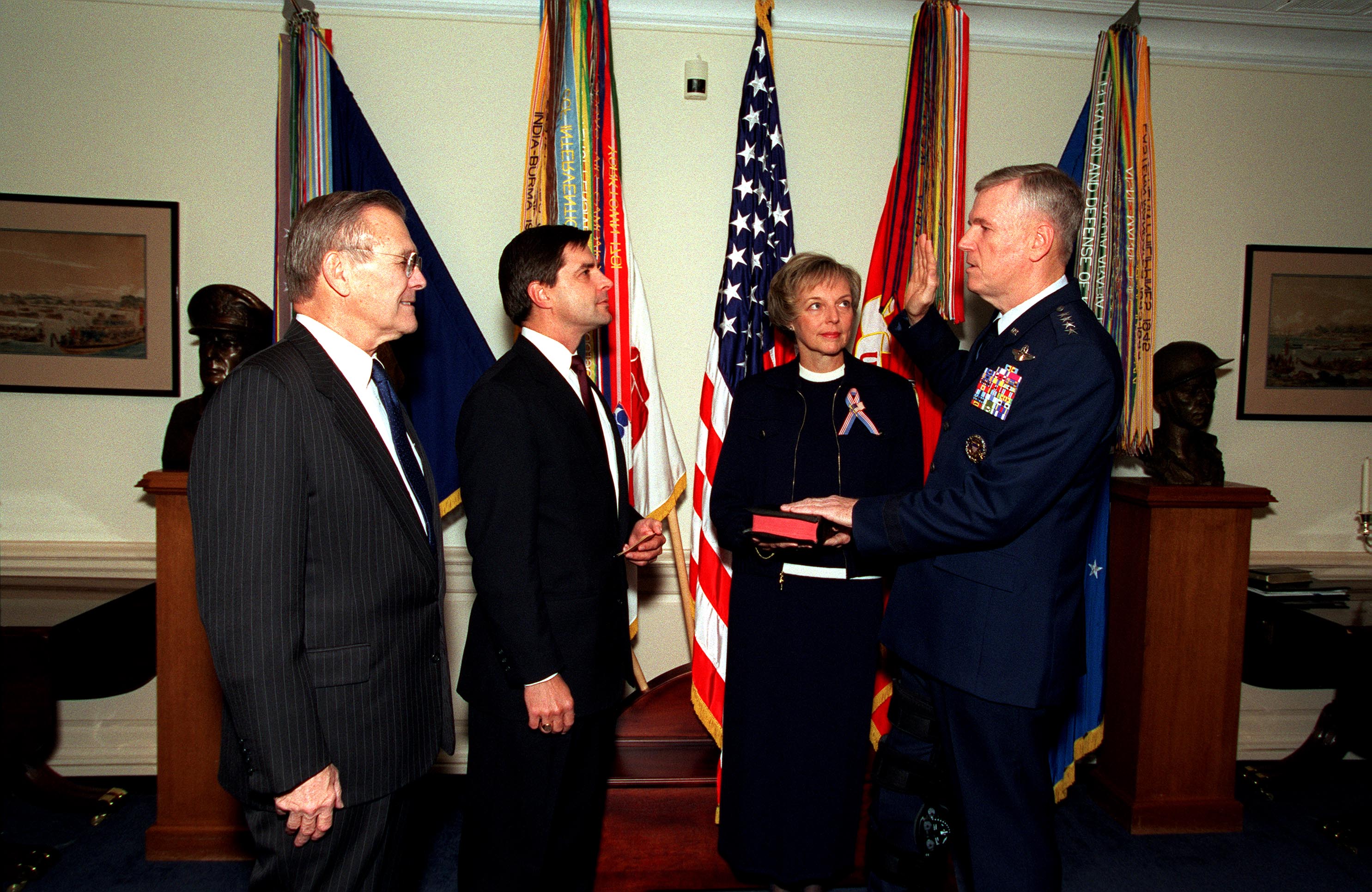
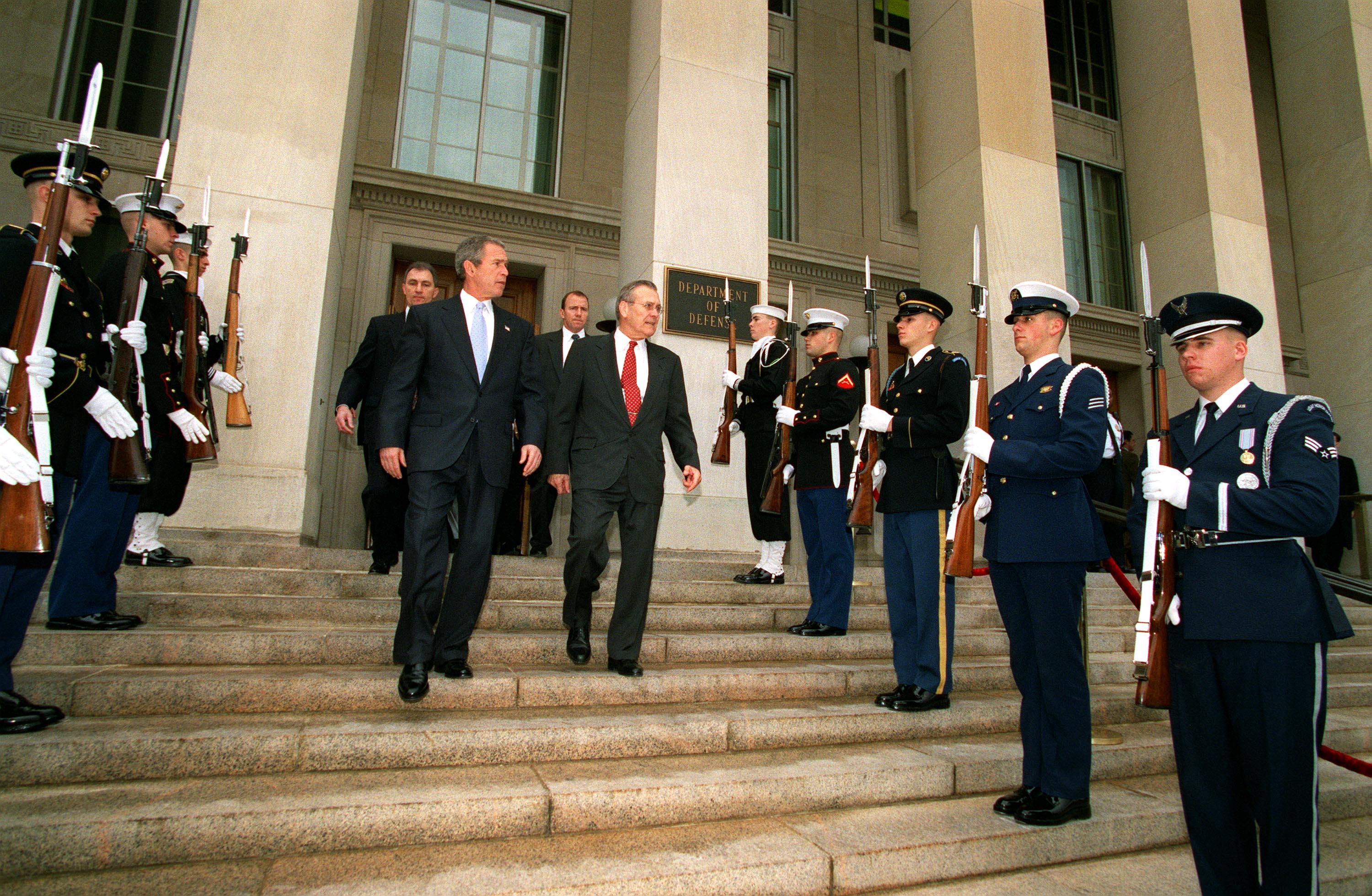
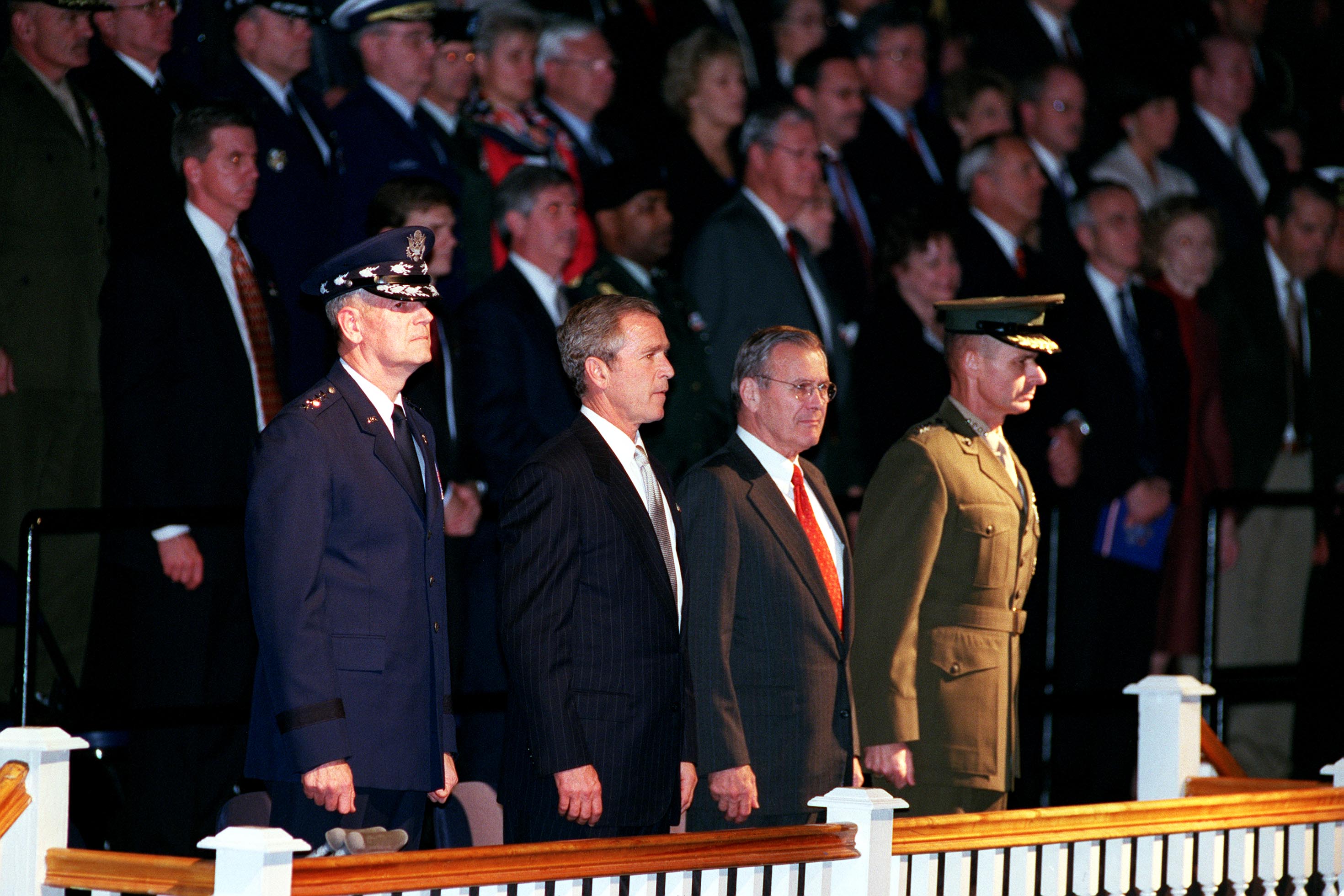
During his time as defense secretary, Rumsfeld was known for his directness and quick wit in press conferences. U.S. News & World Report described him as "a straight-talking Midwesterner" who "routinely has the press corps doubled over in fits of laughter." However, his leadership faced significant criticism in books such as Bob Woodward's State of Denial, Thomas E. Ricks' Fiasco, and Seymour Hersh's Chain of Command, which chronicled the Iraq conflict.
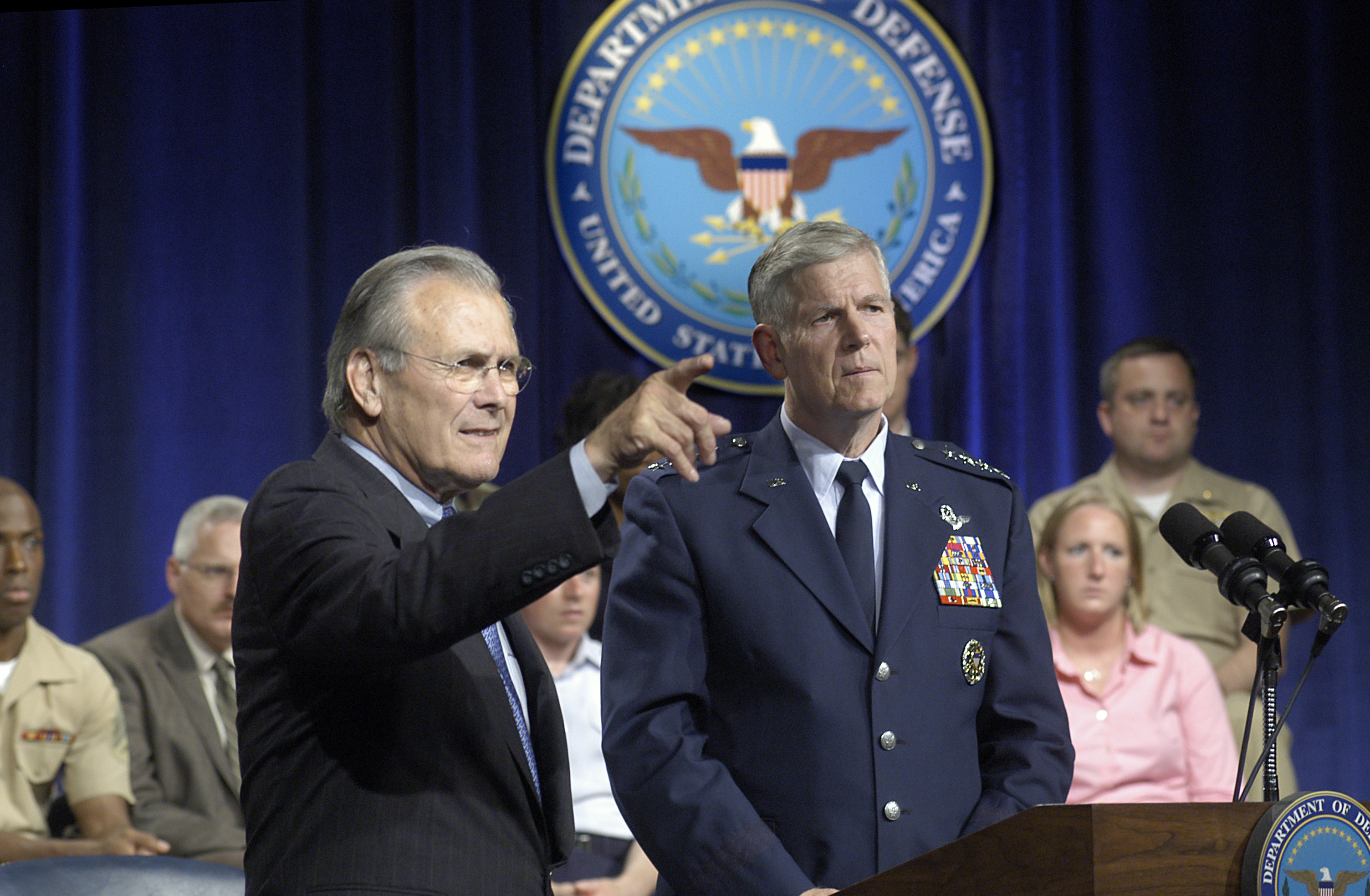
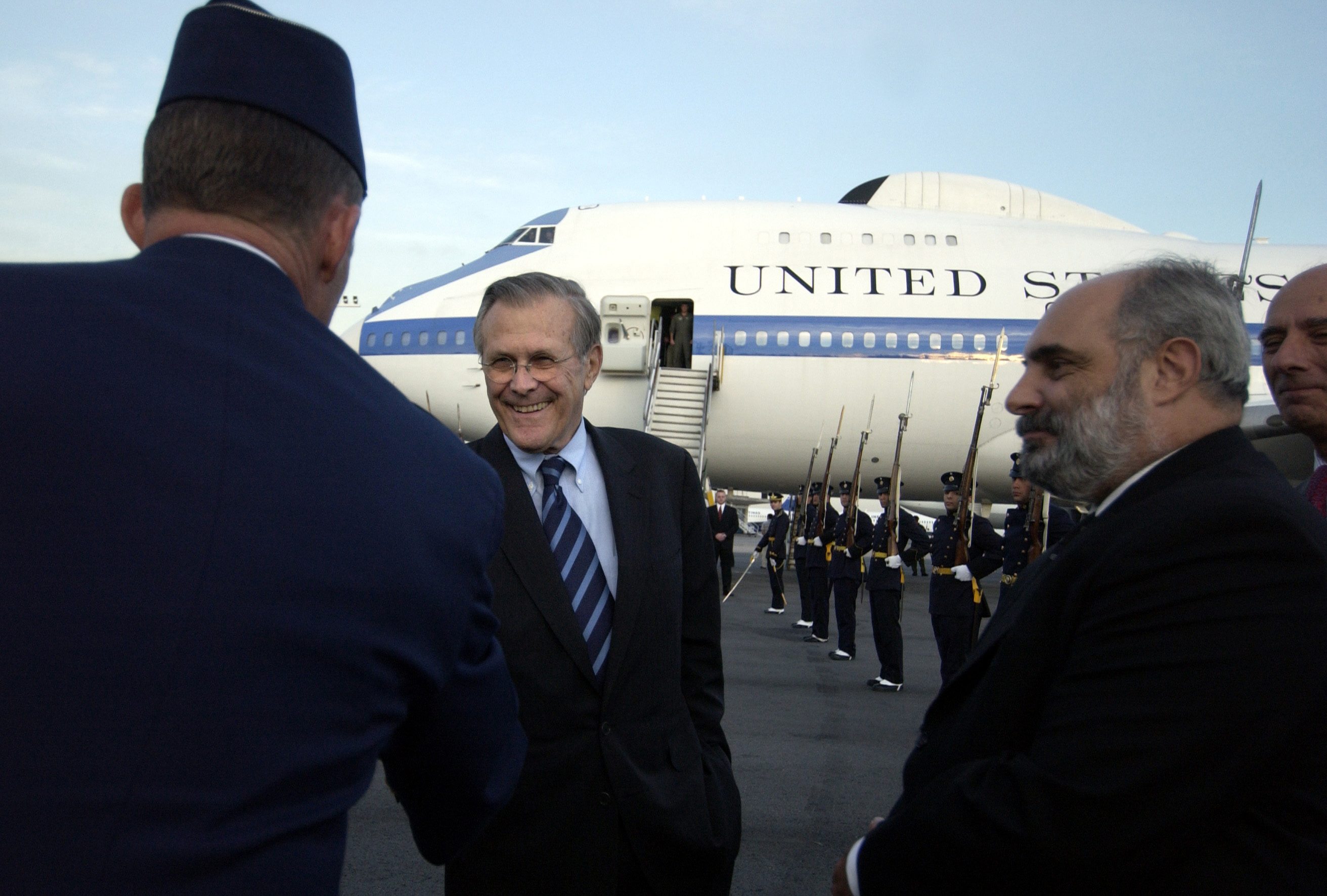
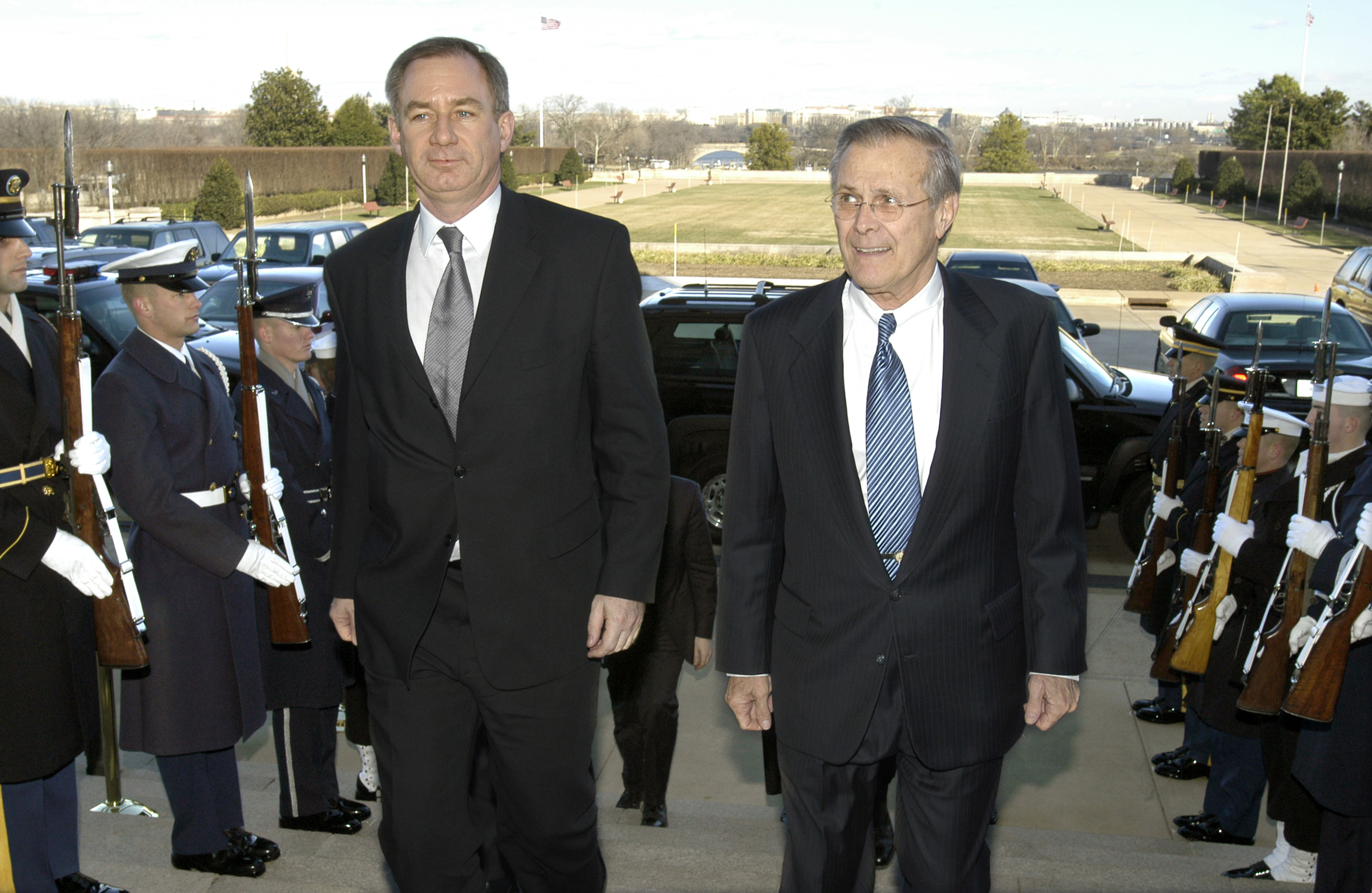
5.1. September 11 attacks and immediate response
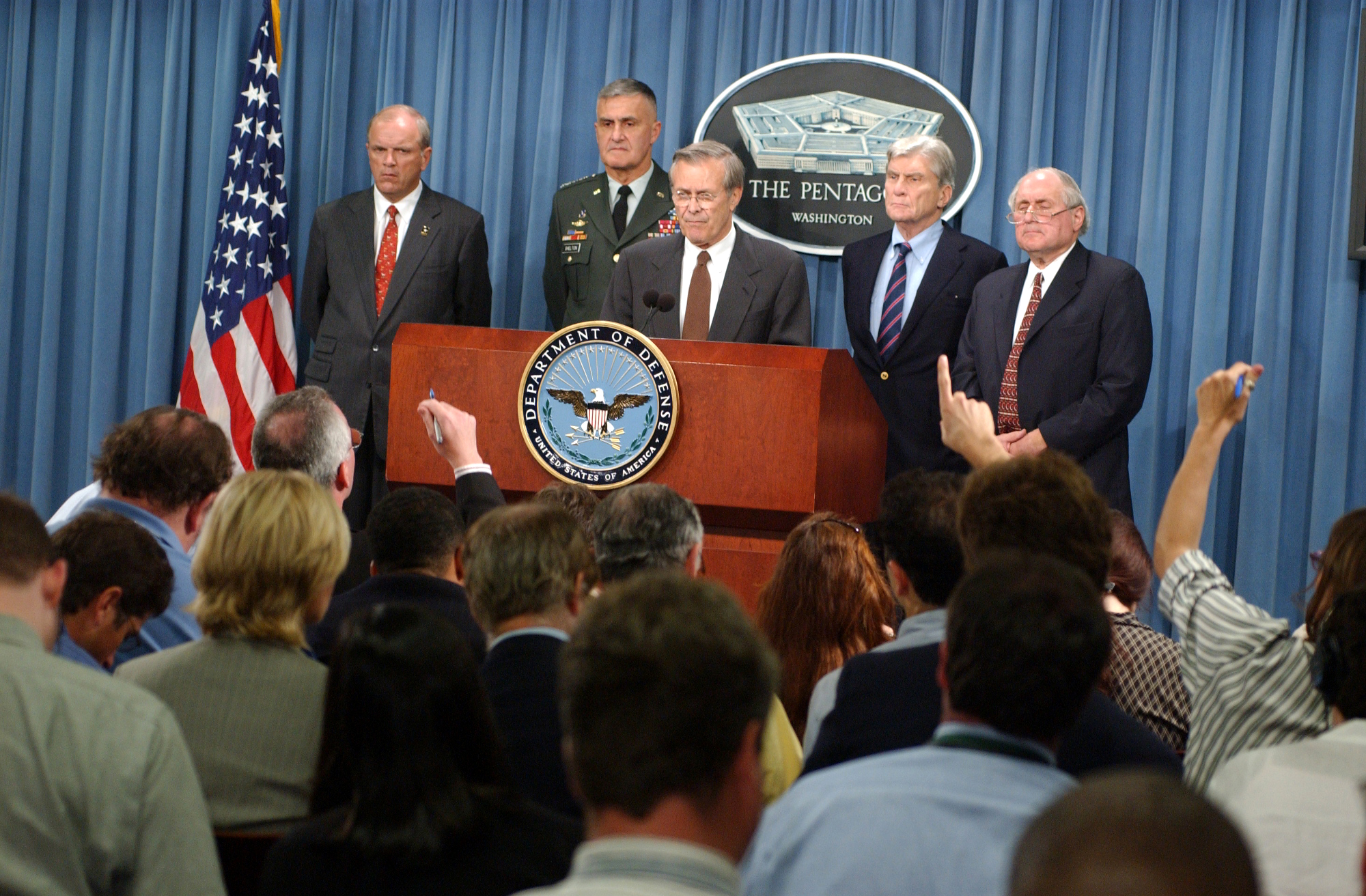
On September 11, 2001, al-Qaeda terrorists hijacked commercial airliners, crashing them into the World Trade Center towers in Lower Manhattan, New York City, and the Pentagon in Washington, D.C. A fourth plane crashed in Shanksville, Pennsylvania, likely en route to the U.S. Capitol Building or the White House. Within three hours of the first hijacking and two hours after American Airlines Flight 11 struck the World Trade Center, Rumsfeld raised the U.S. defensive readiness condition to DEFCON 3, a level not seen since the Arab-Israeli war in 1973.
Just eight hours after the attacks, Rumsfeld addressed the nation in a press conference at the Pentagon, emphasizing, "It's an indication that the United States government is functioning in the face of this terrible act against our country. I should add that the briefing here is taking place in the Pentagon. The Pentagon's functioning. It will be in business tomorrow."
5.2. War in Afghanistan
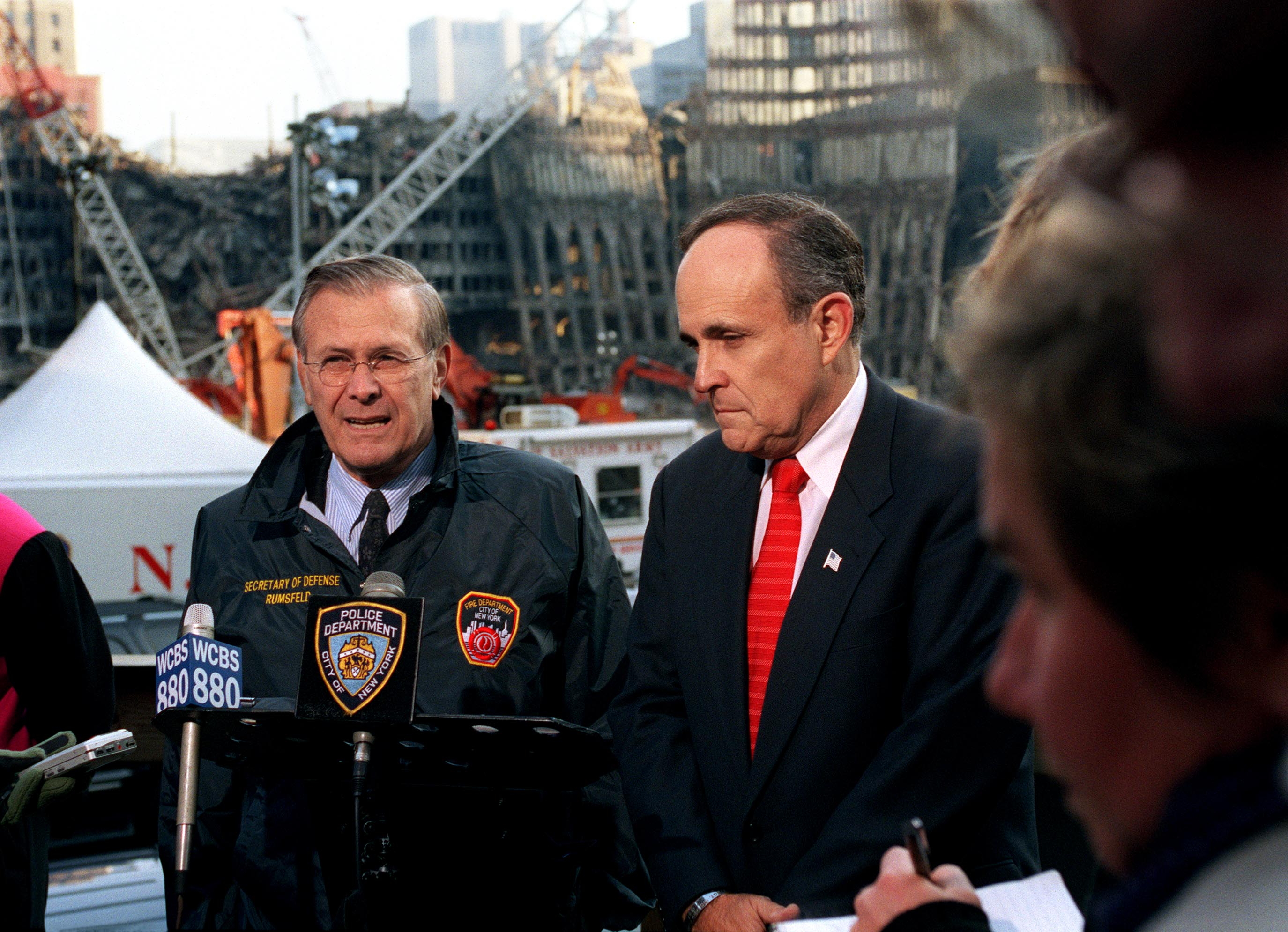
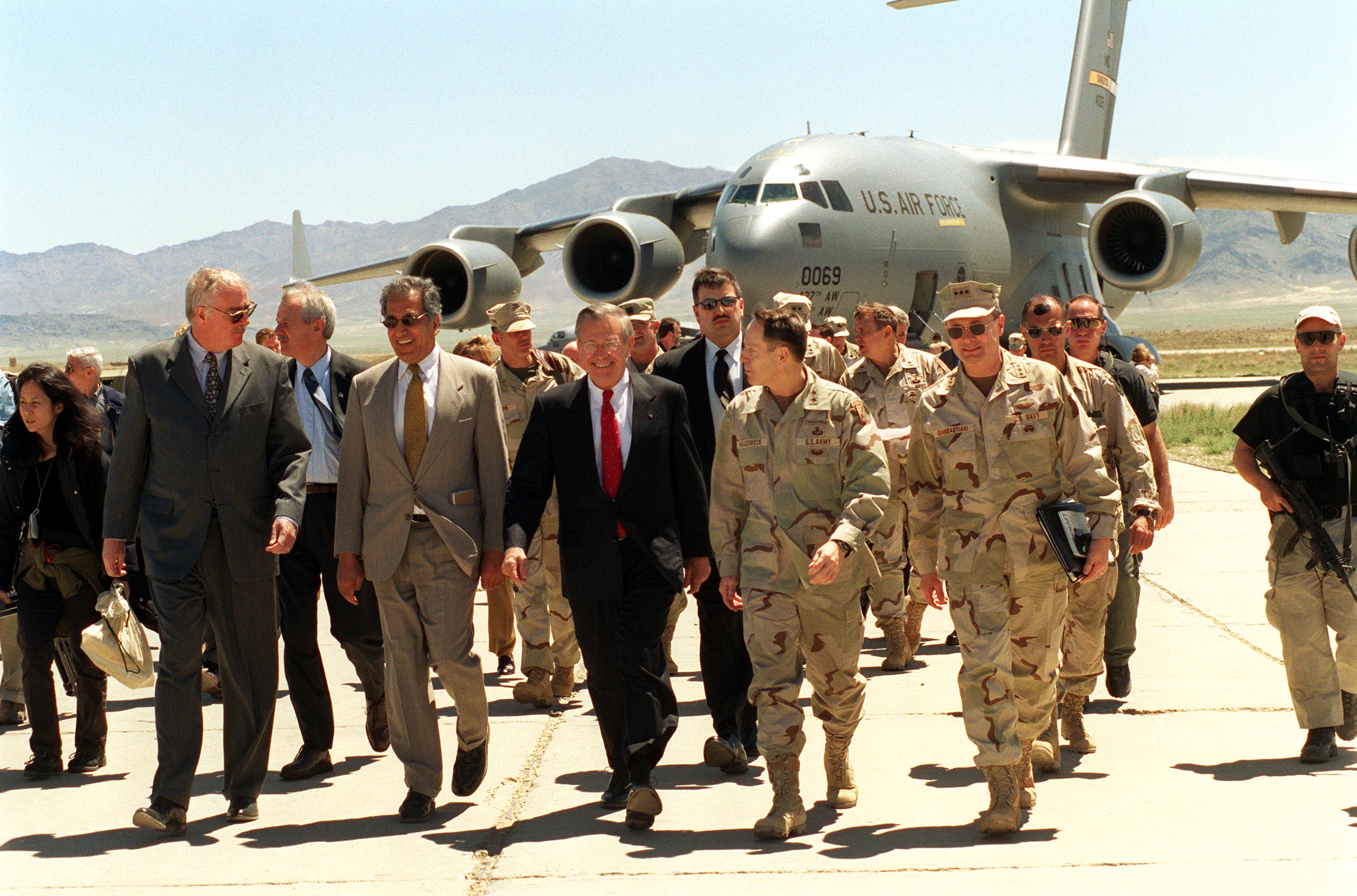
On the afternoon of September 11, Rumsfeld immediately directed his aides to find evidence of possible Iraqi involvement. According to notes by senior policy official Stephen Cambone, Rumsfeld urged, "Best info fast. Judge whether good enough hit S.H." - referring to Saddam Hussein - "at same time. Not only UBL" (Osama bin Laden). He added, "Need to move swiftly - Near term target needs - go massive - sweep it all up. Things related and not."
In the first emergency meeting of the National Security Council on the day of the attacks, Rumsfeld questioned, "Why shouldn't we go against Iraq, not just al-Qaeda?" His deputy, Paul Wolfowitz, added that Iraq was a "brittle, oppressive regime that might break easily-it was doable." According to John Kampfner, Rumsfeld and Wolfowitz "used every available opportunity to press the case" for an attack on Iraq. President George W. Bush initially pushed back, stating, "Wait a minute, I didn't hear a word said about him (Saddam Hussein) being responsible for the attack." Despite this, Rumsfeld and Wolfowitz reportedly held secret meetings about opening a second front against Saddam, excluding Secretary of State Colin Powell. In these meetings, they forged a policy later dubbed the Bush Doctrine, which centered on "pre-emption" and the war on Iraq, a strategy previously advocated by the PNAC.
Richard A. Clarke, the White House counter-terrorism coordinator, revealed that during a National Security Council meeting the day after the attacks, Rumsfeld advocated bombing Iraq, stating, "there aren't any good targets in Afghanistan and there are lots of good targets in Iraq." Rumsfeld even suggested attacking other countries like Libya and Sudan, arguing that a true "global war on terror" required addressing all state sponsors of terrorism.
In his memoir Known and Unknown, Rumsfeld stated, "Much has been written about the Bush administration's focus on Iraq after 9/11. Commentators have suggested that it was strange or obsessive for the President and his advisers to have raised questions about whether Saddam Hussein was somehow behind the attack. I have never understood the controversy. I had no idea if Iraq was or was not involved, but it would have been irresponsible for any administration not to have asked the question." A memo written by Rumsfeld dated November 27, 2001, explicitly considered an Iraq war and listed multiple possible justifications for a U.S.-Iraq conflict.
Rumsfeld directed the planning for the War in Afghanistan after the September 11 attacks. Initially, USCENTCOM Commander General Tommy Franks proposed a conventional invasion using 60,000 troops with six months of preparation. Rumsfeld, however, feared a repeat of the Soviet experience in the Soviet-Afghan War or the 1842 retreat from Kabul by the British. He rejected Franks's plan, demanding, "I want men on the ground now!" The next day, Franks presented a plan utilizing U.S. Special Forces. Despite existing air and missile attack plans, USCENTCOM had no pre-existing plans for ground operations in Afghanistan.
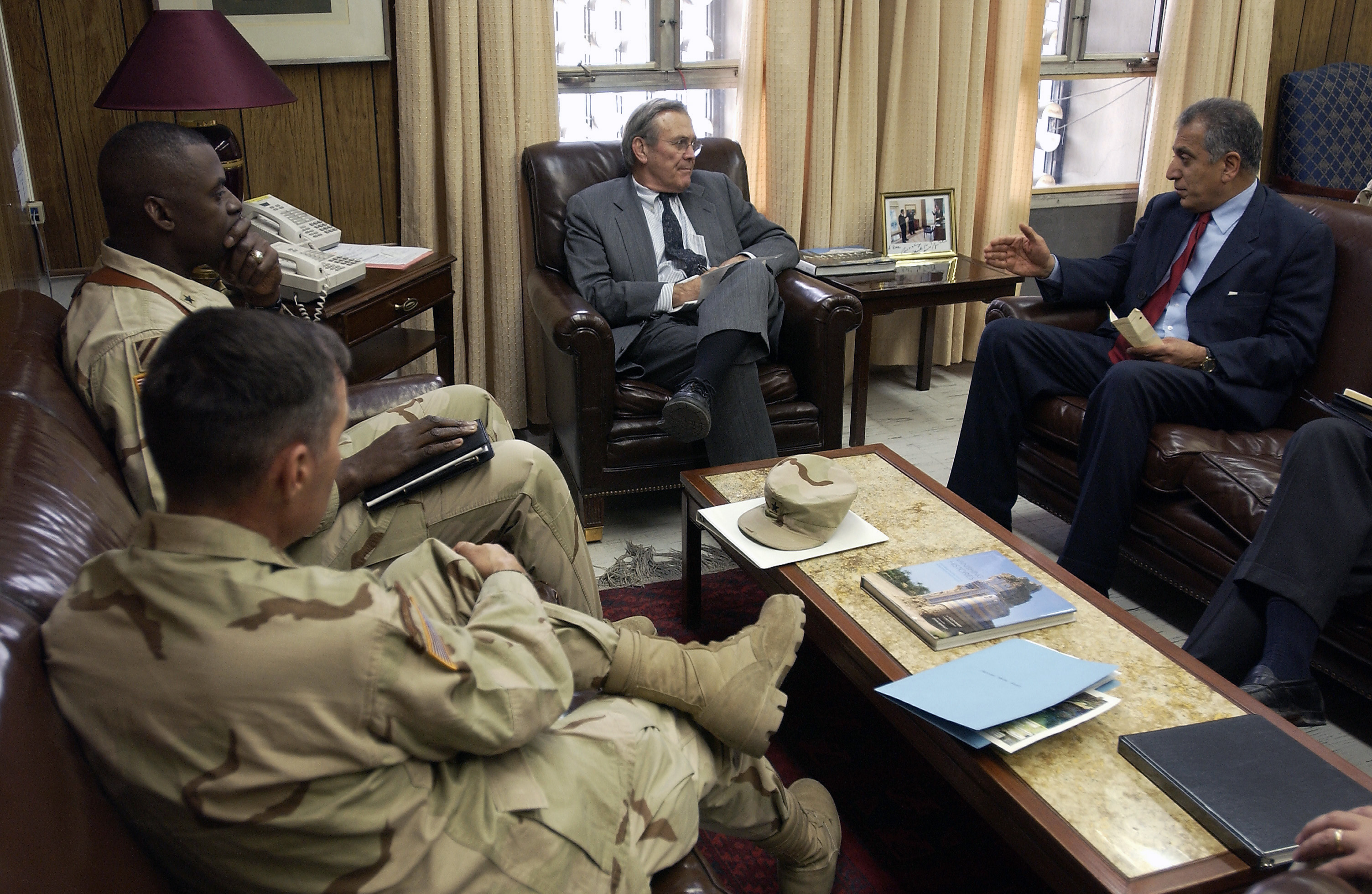
The Special Forces plan emerged after extensive dialogue, but Rumsfeld also requested broader plans that looked beyond Afghanistan. On October 7, 2001, hours after the 2001 invasion of Afghanistan began, Rumsfeld stated that while raids focused on the Taliban and foreign terrorists, the broader aim was "to defeat those who use terrorism and those who house or support them. The world stands united in this effort." He emphasized that countering terrorist threats required engaging them "where they exist" and that "the only way to deal with it is to take the battle to where they are and to root them out."
On October 29, 2001, Rumsfeld reiterated the goal to "deal with it comprehensively" and "not to stop until we've rooted out terrorist networks and put them out of business, not just in the case of the Taliban and the Al Qaeda in Afghanistan, but other networks as well." In November 2001, Rumsfeld announced "authoritative reports" of the death of al-Qaeda's third-in-command, Mohammed Atef, a key planner of the September 11 attacks, in a U.S. airstrike, noting, "He was very, very senior."
Rumsfeld described the role of U.S. ground forces in Afghanistan as twofold: in the north, American troops were "embedded in Northern Alliance" elements, assisting with logistics and pinpointing airstrikes; in the south, commandos operated more independently, conducting raids and monitoring areas to gather intelligence on al-Qaeda and Taliban leaders. On December 16, 2001, Rumsfeld visited U.S. troops at Bagram Air Base in Afghanistan. On March 15, 2002, he commented on Operation Anaconda, noting that fighting was winding down and coalition forces were in an "exploitation phase," searching caves and clearing battle areas, finding weapons and intelligence. He reported that some top al-Qaeda and Taliban figures were dead or captured, with many others' statuses unknown.
On May 1, 2003, during a visit to U.S. troops in Kabul, Rumsfeld told the press that major combat activity had transitioned to "a period of stability and stabilization and reconstruction." However, he underlined that "there are still dangers, there are still pockets of resistance."
There was also controversy between the Pentagon and the CIA over who had the authority to fire Hellfire missiles from Predator drones. Although the drones were not ready for deployment until 2002, some critics argued that these quarrels prevented the Predator from being used against al-Qaeda, calling Rumsfeld an "obstacle" who "helped the terrorists."
In December 2005, Rumsfeld again visited Kabul, meeting with Afghan Defense Minister Rahim Wardak. During this meeting, Rumsfeld expressed doubts about the effectiveness of the Afghan army and attributed the worsening situation in Afghanistan to ineffective governance. He criticized the long-standing plan to expand the Afghan army to 70,000 troops and requested a reduction to a maximum of 52,000, claiming this was necessary to "suit Afghanistan's limited revenues." Shortly after this trip, Rumsfeld also withdrew 3,000 U.S. troops from Afghanistan and canceled the planned deployment of an army brigade.
In 2009, three years after Rumsfeld's tenure ended, the United States Senate Committee on Foreign Relations investigated the Battle of Tora Bora in December 2001. They concluded that Rumsfeld and General Franks had not committed enough troops during the battle to secure the area around Tora Bora. They believed that al-Qaeda leader Osama bin Laden had likely been at Tora Bora and his escape prolonged the war in Afghanistan. Rumsfeld and Franks were reportedly motivated by a fear that a substantial American presence near Tora Bora could incite a rebellion by local Pashtuns, despite their lack of organizational capability at the time. This decision was made despite fierce dissent from CIA analysts, including Charles E. Allen and Gary Berntsen, who called for army rangers to "kill this baby in the crib." Instead of Rangers or Marines, the U.S. assault relied on CIA-backed Afghan militias, supplemented by B-52 bombardment. The resulting influx of hundreds of al-Qaeda fighters into Pakistan destabilized the country and damaged Pakistan-United States relations. The subsequent Operation Anaconda also suffered from "failures of planning and execution, the product of fractured lines of command." In mid-2002, Rumsfeld controversially announced that "The war is over in Afghanistan," to the disbelief of many State Department, CIA, and military officials in the country. Consequently, Rumsfeld downplayed the need for an Afghan army of even 70,000 troops, far fewer than the 250,000 envisaged by President Hamid Karzai.
Regarding military modernization, Rumsfeld's leadership saw a notable "diet" in the U.S. military. Despite the global prevalence of 4th generation fighter jets, Rumsfeld oversaw the reduction of F-22 5th generation fighter production from 700 units to 200. Additionally, programs for the RAH-66 Comanche attack helicopter and the Crusader self-propelled howitzer were canceled, impacting the U.S. military's future capabilities and readiness.
5.3. Iraq War
The Iraq War was a significant and controversial period during Rumsfeld's second term as Secretary of Defense, characterized by debates over intelligence, troop levels, and public messaging.
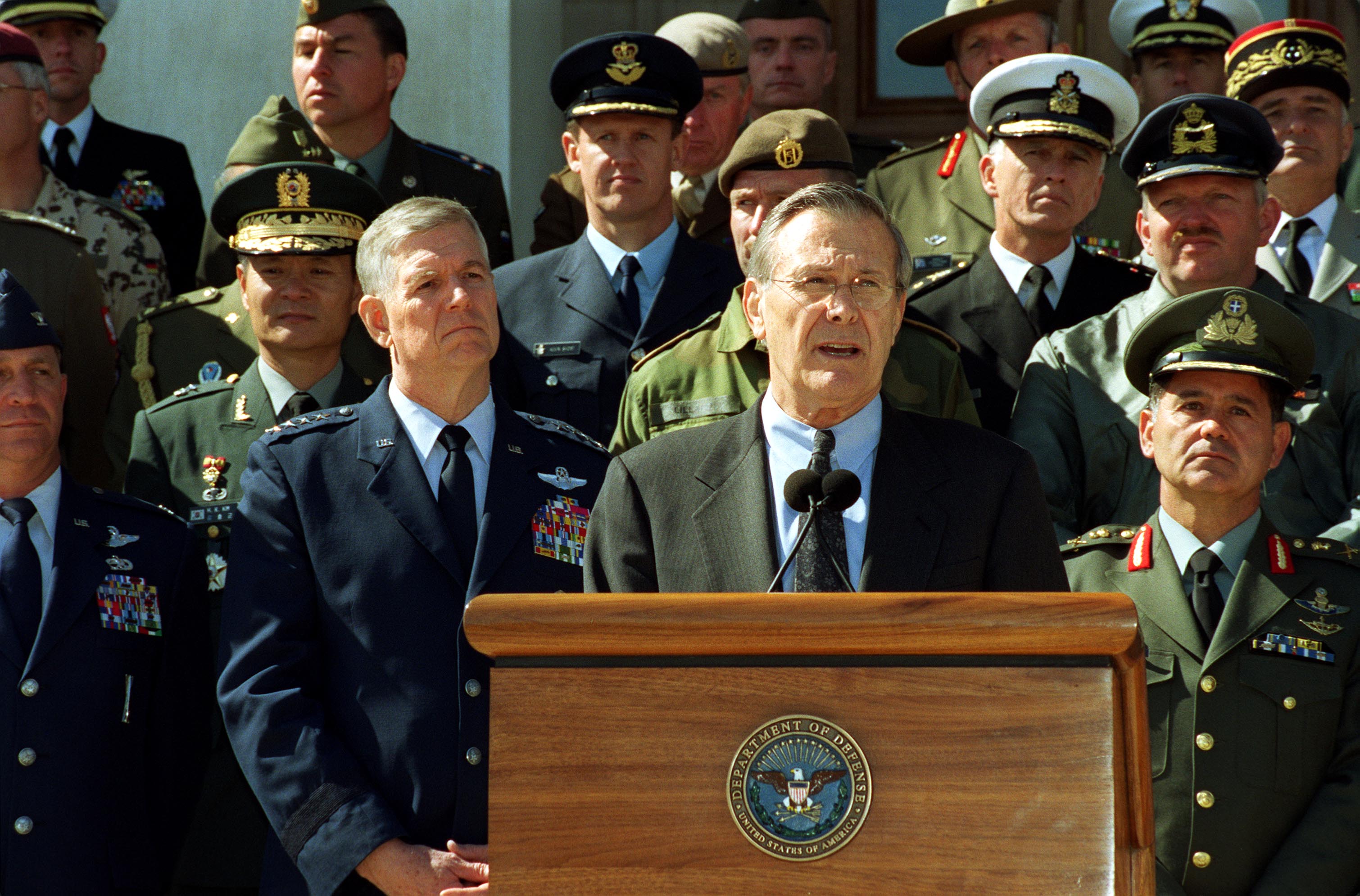
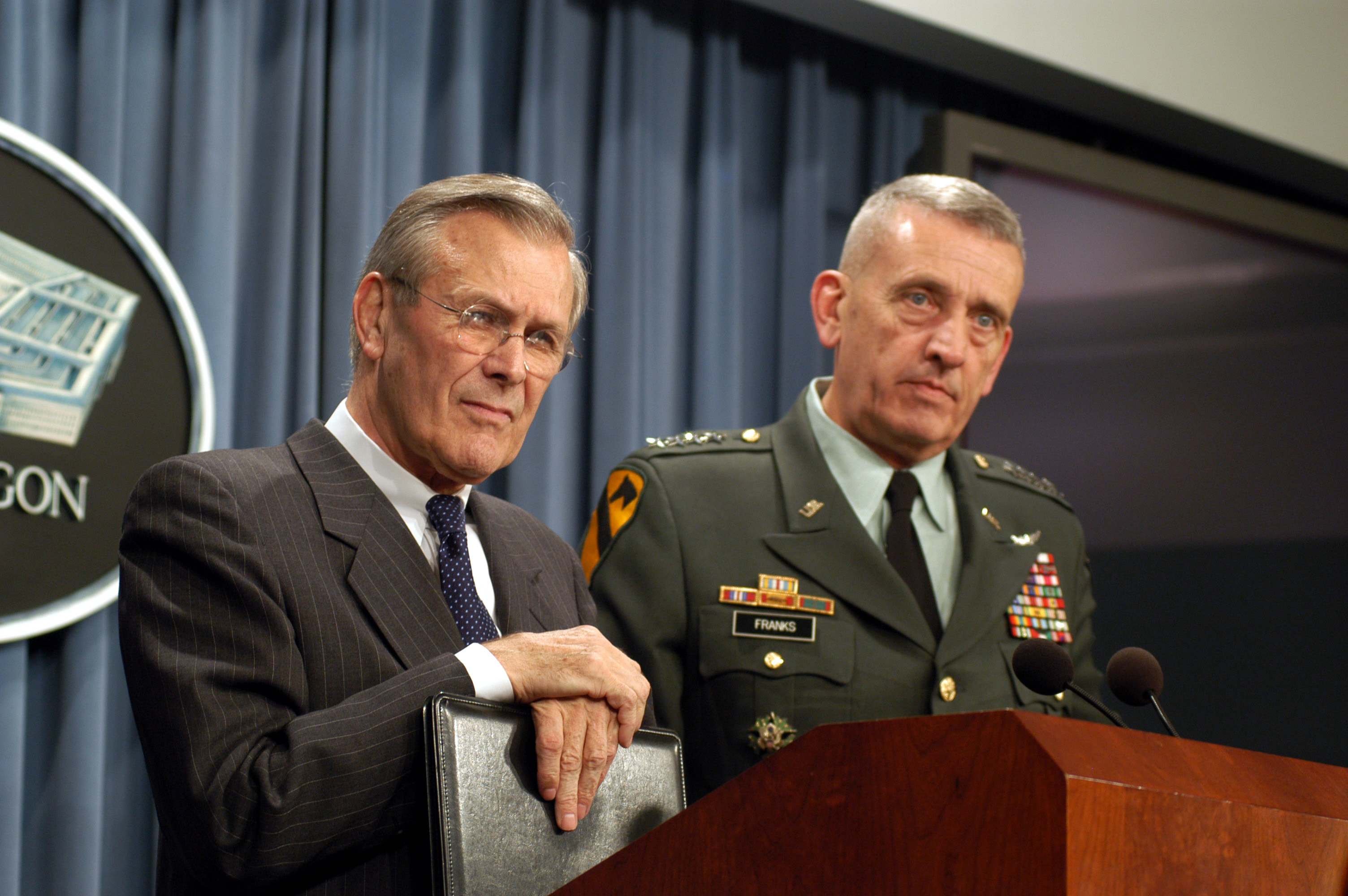
5.3.1. WMD claims and intelligence manipulation
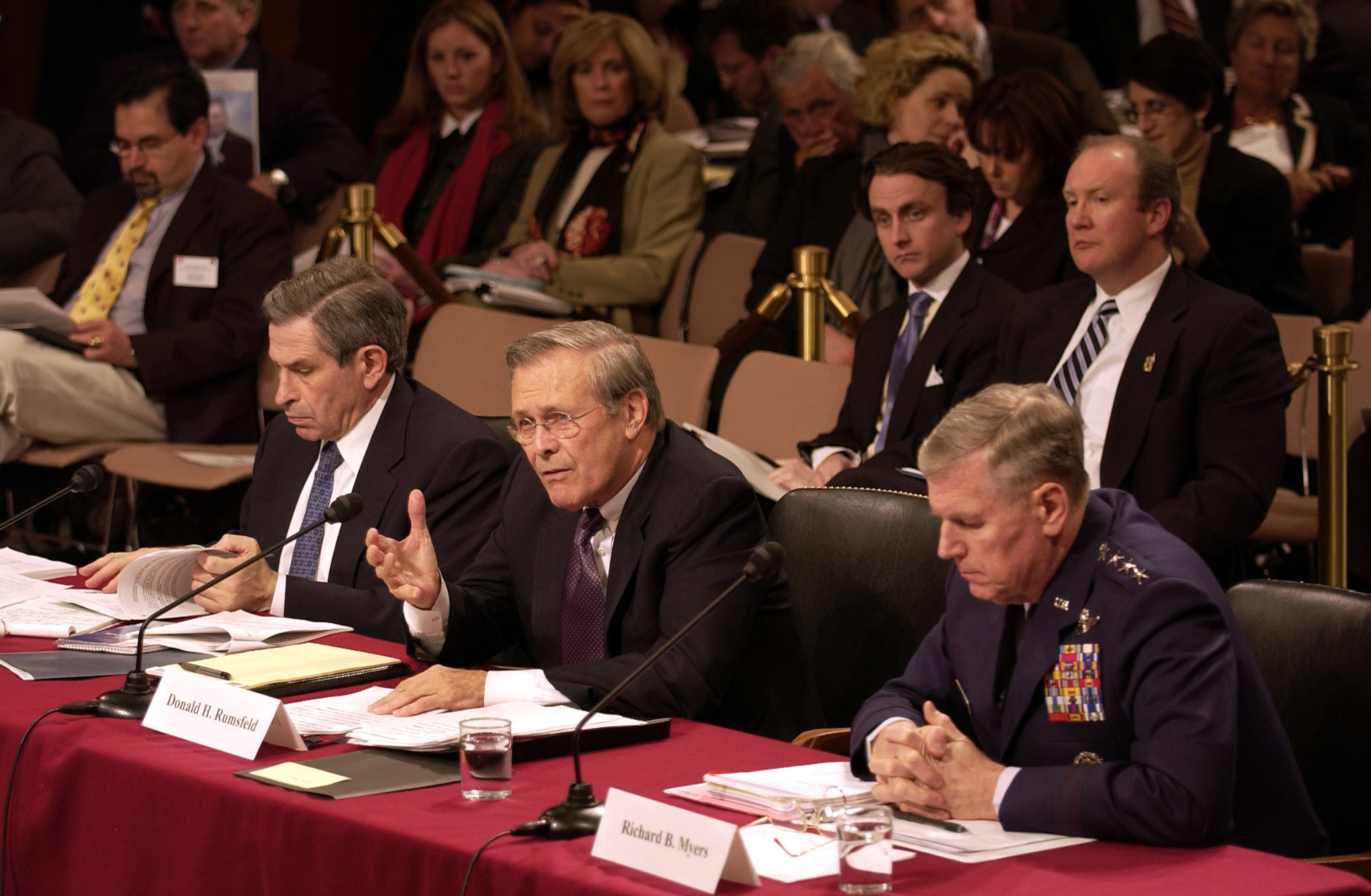
Before and during the Iraq War, Rumsfeld and other Bush administration officials repeatedly asserted that Iraq possessed an active weapons of mass destruction (WMD) program. His statements included the famous "there are known knowns" phrase during a Pentagon press conference on February 12, 2002. However, no WMD stockpiles were ever found. Bush administration officials also asserted an operational relationship between Al-Qaeda and Saddam Hussein. A Pentagon Inspector General report found that Rumsfeld's top policy aide, Douglas J. Feith, "developed, produced, and then disseminated alternative intelligence assessments on the Iraq and al-Qaeda relationship, which included some conclusions that were inconsistent with the consensus of the Intelligence Community, to senior decision-makers." On March 30, 2003, in an interview, Rumsfeld stated regarding the location of WMDs: "We know where they are. They're in the area around Tikrit and Baghdad and east, west, south and north somewhat."
The responsibility for finding WMDs and justifying the attack fell to intelligence services. However, Rumsfeld and Wolfowitz reportedly believed these services were too bureaucratic and traditional. Consequently, they established a "cabal," a small cell of analysts within a new Office of Special Plans (OSP) at the U.S. Defense Department. According to an unnamed Pentagon source, the OSP "was created in order to find evidence of what Wolfowitz and his boss, Defense Secretary Rumsfeld, believed to be true-that Saddam Hussein had close ties to Al Qaeda, and that Iraq had an enormous arsenal of chemical, biological, and possibly even nuclear weapons that threatened the region and, potentially, the United States."
5.3.2. Troop levels and strategy
Rumsfeld's approach to troop levels and military strategy for the Iraq War was a source of significant debate and criticism. After the war in Afghanistan was launched, Rumsfeld participated in a meeting reviewing the Department of Defense's Contingency Plan for a potential war with Iraq. The plan, as conceived, envisioned troop levels of up to 500,000, which Rumsfeld deemed excessive. As authors Gordon and Trainor noted, Rumsfeld found the plan to be "the product of old thinking and the embodiment of everything that was wrong with the military," requiring too many troops and supplies and too much time to execute. At a press conference on February 27, 2003, Rumsfeld dismissed General Eric Shinseki's suggestion that "several hundred thousand troops" would be necessary to secure Iraq and provide stability, stating it was "far from the mark" and that other countries had already offered forces.
The strategy Rumsfeld oversaw for the Iraq War, known as "Shock and Awe," aimed for a rapid, decisive invasion. This approach utilized approximately 145,000 soldiers on the ground, leading to the swift capture of Baghdad in less than a month with relatively few American casualties during the initial phase. However, this minimalist approach was widely criticized for leading to significant instability and a prolonged insurgency after the initial military victory. Many government buildings, major museums, electrical infrastructure, and even oil facilities were looted and vandalized during the power vacuum following the fall of Saddam Hussein's regime and before the establishment of the Coalition Provisional Authority. The ensuing violent insurgency became a major challenge for the U.S. forces. On March 20, 2003, just hours after the launch of the 2003 invasion of Iraq, Rumsfeld announced at a Pentagon press conference that the "days of the Saddam Hussein regime are numbered" and that "there is no need for a broader conflict if the Iraqi leaders act to save themselves."
Rumsfeld's decisions sparked controversy regarding whether the forces deployed to Iraq were sufficient. In 2006, he responded to a question from Brit Hume of Fox News about whether he pressed General Tommy Franks to lower his request for 400,000 troops: "Absolutely not. That's a mythology. This town [Washington, D.C.] is filled with this kind of nonsense. The people who decide the levels of forces on the ground are not the Secretary of Defense or the President. We hear recommendations, but the recommendations are made by the combatant commanders and by members of the Joint Chiefs of Staff and there hasn't been a minute in the last six years when we have not had the number of troops that the combatant commanders have requested." Rumsfeld maintained that Franks ultimately decided against such a troop level.
In September 2007, General Mike Jackson, head of the British Army during the invasion, criticized Rumsfeld's plans for the invasion of Iraq as "intellectually bankrupt." Jackson stated that Rumsfeld was "one of those most responsible for the current situation in Iraq" and that the U.S. approach to combating global terrorism was "inadequate" and too focused on military might rather than nation building and diplomacy.
5.3.3. Public relations and messaging
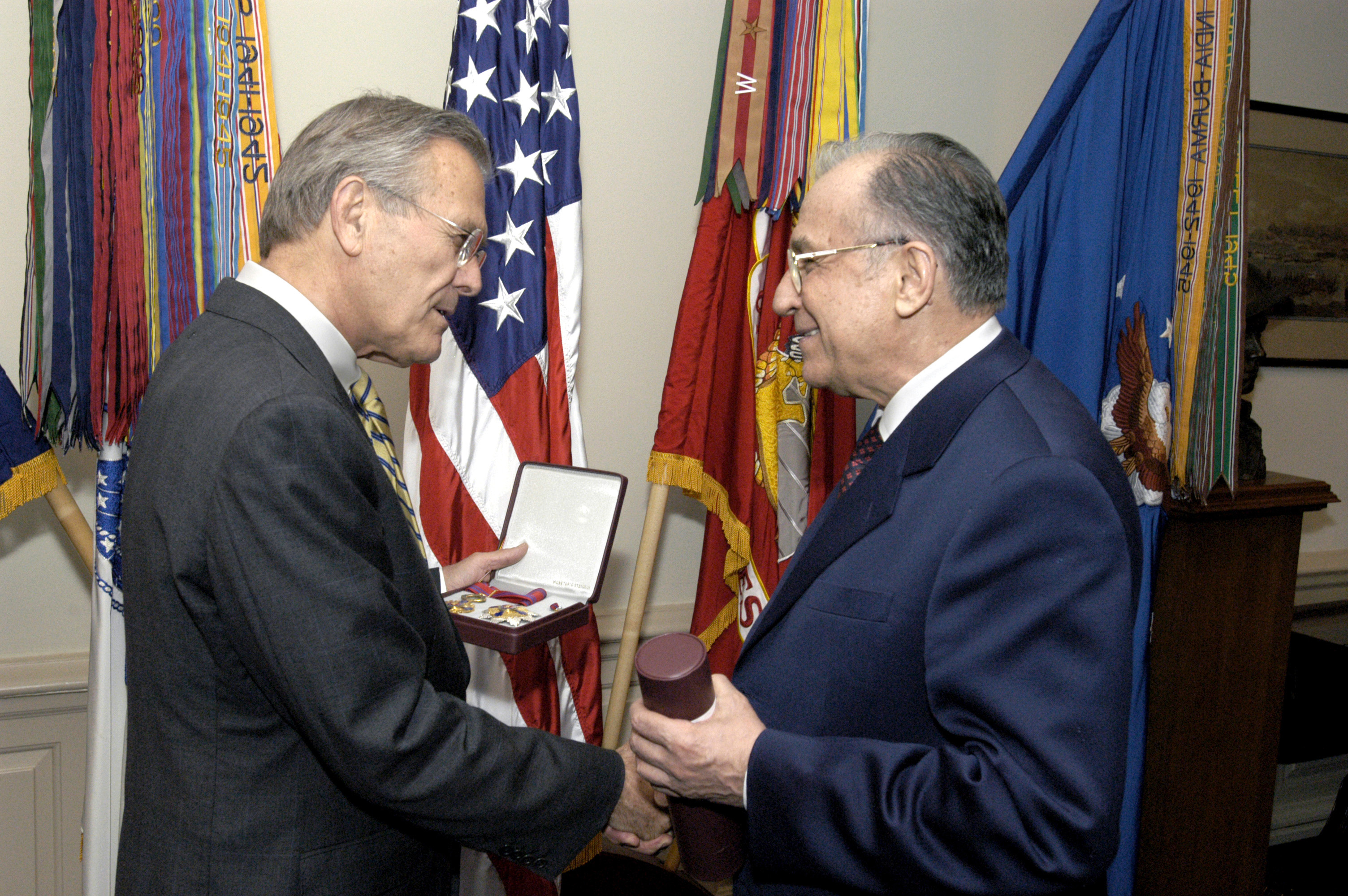
Rumsfeld was highly engaged in the public communication of the Iraq War, often delivering memorable and sometimes controversial statements. On January 22, 2003, after the German and French governments voiced opposition to invading Iraq, Rumsfeld famously labeled these countries as part of "Old Europe," implying that nations supporting the war represented a more modern Europe. On April 9, 2003, during the Fall of Baghdad, he described the scenes of "free Iraqis celebrating in the streets, riding American tanks, tearing down the statues of Saddam Hussein in the center of Baghdad" as "breathtaking."
However, his messaging drew heavy criticism after U.S. troops were blamed for not protecting historical artifacts and treasures during the looting of the National Museum of Iraq. On April 11, 2003, when asked why U.S. troops did not intervene to stop the lawlessness, Rumsfeld famously responded, "Stuff happens... and it's untidy and freedom's untidy, and free people are free to make mistakes and commit crimes and do bad things. They're also free to live their lives and do wonderful things. And that's what's going to happen here." He further downplayed the extent of the looting, saying, "The images you are seeing on television you are seeing over, and over, and over, and it's the same picture of some person walking out of some building with a vase, and you see it 20 times, and you think, 'My goodness, were there that many vases?'"
On July 24, 2003, Rumsfeld defended the decision to release photographs of the deceased sons of Saddam Hussein, Uday Hussein and Qusay Hussein. He stated that while it was "not a practice that the United States engages in on a normal basis," he believed it was "important for the Iraqi people to see them, to know they're gone, to know they're dead, and to know they're not coming back." He concluded, "I feel it was the right decision, and I'm glad I made it."
In October 2003, Rumsfeld approved a secret Pentagon "roadmap" on public relations, which sought to establish "boundaries" between information operations abroad and the news media at home. This policy advanced the idea that as long as the U.S. government did not intentionally target the American public, it was acceptable for psychological operations to reach the American public. On December 14, 2003, following Saddam Hussein's capture in Operation Red Dawn, Rumsfeld remarked on Hussein's lack of bravery, noting that Hussein, who was "photographed hundreds of times shooting off rifles... was cowering in a hole in the ground."
As Secretary of Defense, Rumsfeld was deliberate in shaping the public message from the Department of Defense. He noted that people would "rally" to the word "sacrifice," and that "Sacrifice = Victory." In May 2004, he considered redefining the war on terrorism as a fight against "worldwide insurgency" and ordered aides to "test what the results could be" if the term were changed. Rumsfeld also ordered specific public Pentagon attacks on and responses to U.S. newspaper columns that reported negative aspects of the war.
Throughout his tenure, Rumsfeld regularly visited U.S. troops stationed in Iraq. On September 24, 2004, the Australian Broadcasting Corporation reported that Rumsfeld did not specify a withdrawal date for troops in Iraq, but stated it "would be unrealistic to wait for Iraq to be peaceful before removing U.S. led forces from the country, adding that Iraq had never been peaceful and perfect."
On August 2, 2006, at a Pentagon press conference, Rumsfeld commented on the sectarian violence in Iraq, stating "there's sectarian violence; people are being killed. Sunnis are killing Shi'a and Shi'a are killing Sunnis. Kurds seem not to be involved. It's unfortunate, and they need a reconciliation process." On October 26, 2006, after the failure of Operation Together Forward in Iraq, Rumsfeld argued that "defeat in Iraq" would be detrimental, as those fighting the Iraqi government aimed to establish "a new sanctuary and a base of operations for terrorists." He also asserted that the military was "continuing to adapt and to adjust as required," despite difficulties.
Throughout his tenure, Rumsfeld consistently sought to remind the American public of the 9/11 attacks and ongoing threats, noting in a 2006 memo to "[m]ake the American people realize they are surrounded in the world by violent extremists." It was also alleged that Rumsfeld included biblical quotes in top-secret briefing papers for President George W. Bush to frame the invasion of Iraq as a "holy war" or "religious crusade" against Muslims.
In December 2004, Rumsfeld faced heavy criticism for using an autopen machine instead of personally signing over 1,000 letters of condolence to the families of soldiers killed in action in Iraq and Afghanistan. He subsequently promised to personally sign all future letters.
5.4. Prisoner abuse and torture concerns
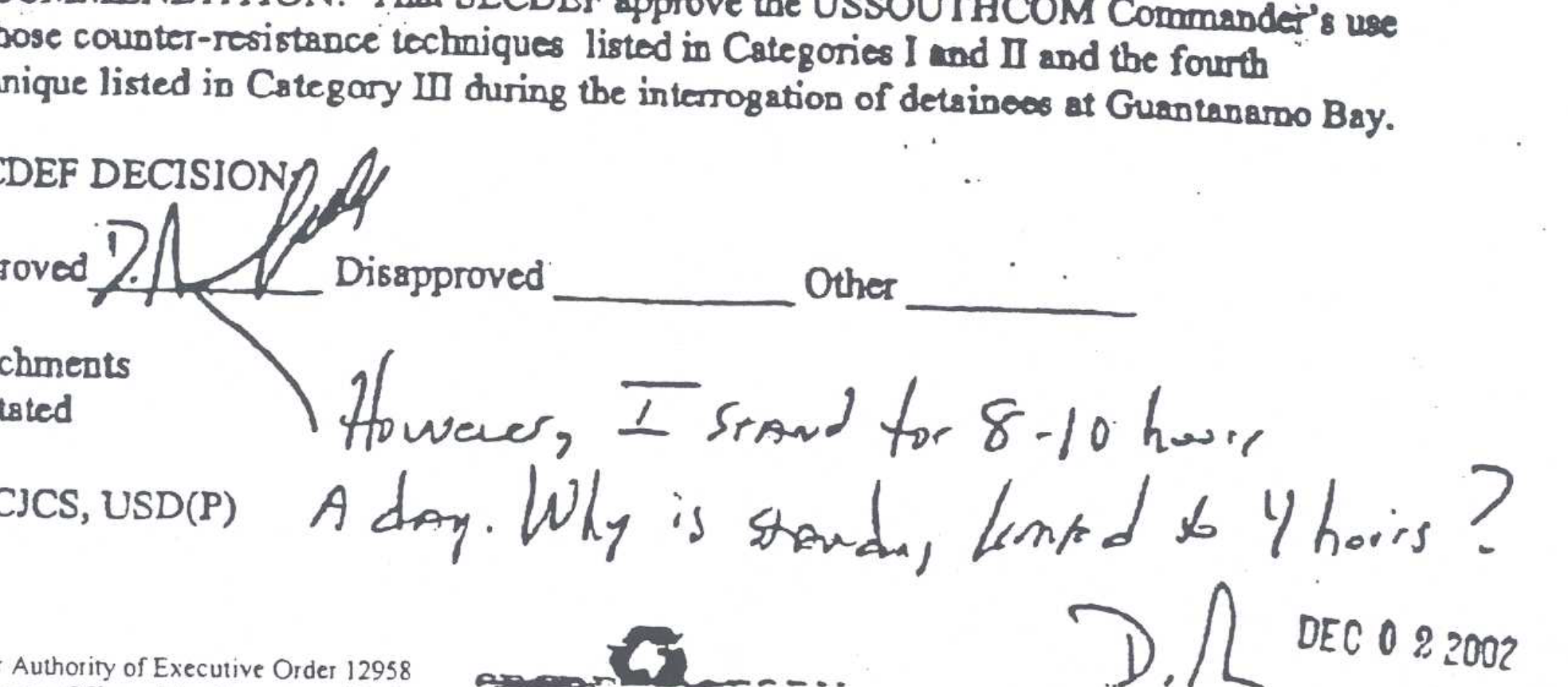
Preliminary concerns within the Department of Defense regarding the holding, housing, and interrogation of captured prisoners in the lead-up to the Iraq War were raised. Due to the rapid surrender of Saddam Hussein's military forces, many within the DOD, including Rumsfeld and United States Central Command General Tommy Franks, initially decided to hand these prisoners over to their respective countries, deeming a large holding facility unrealistic at the time. Instead, various facilities, such as Abu Ghraib, were used to house prisoners of interest before their transfer. Rumsfeld publicly defended the Bush administration's decision to detain enemy combatants.
Consequently, critics, including members of the U.S. Senate Armed Services Committee, held Rumsfeld accountable for the ensuing Abu Ghraib torture and prisoner abuse scandal. Rumsfeld acknowledged, "These events occurred on my watch as Secretary of Defense. I am accountable for them." He offered his resignation to President Bush in the wake of the scandal, but it was not accepted.
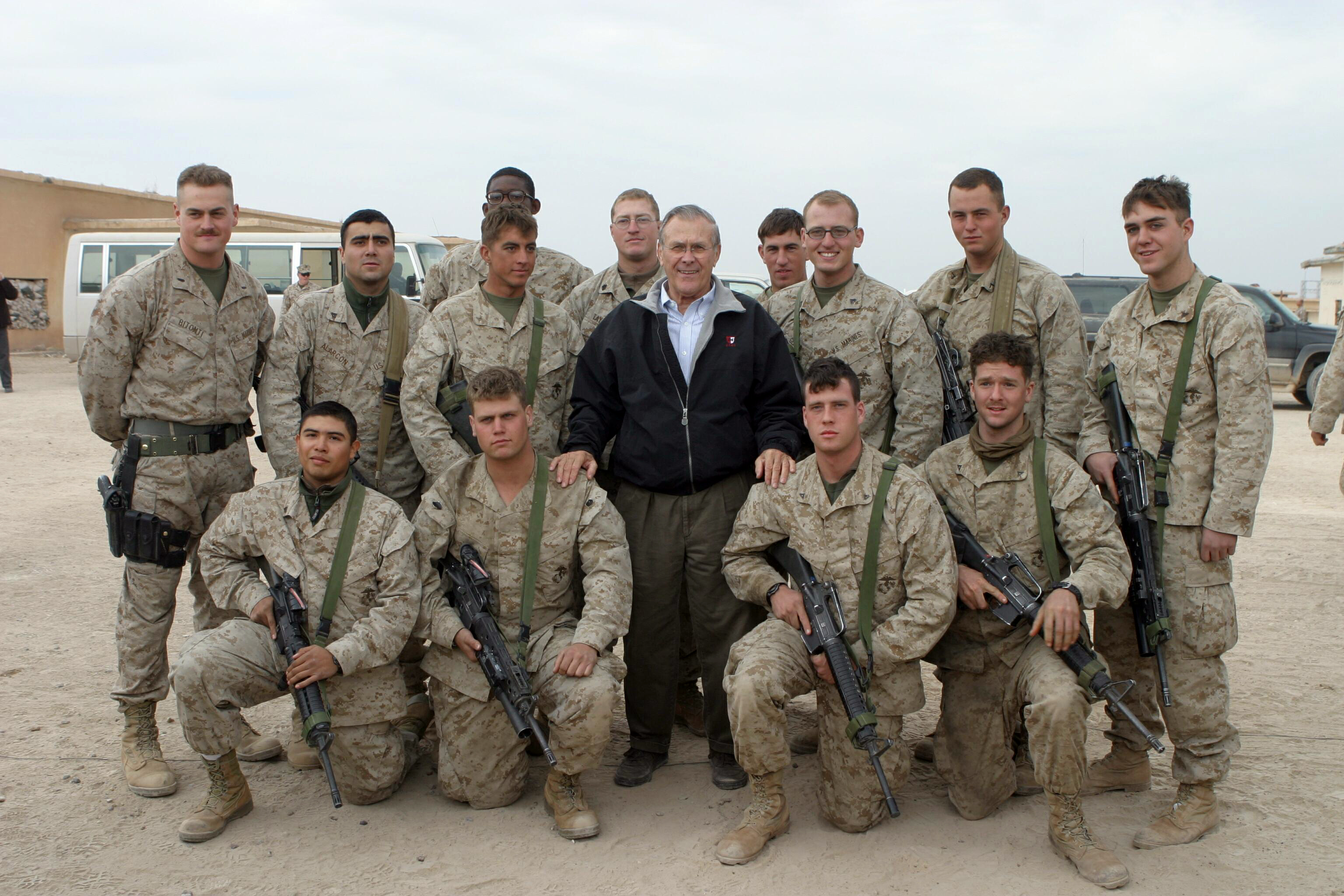
A particular point of contention arose from a memo detailing interrogation techniques at Guantanamo Bay detention camp, which allowed interrogators to induce stress by forcing prisoners to stand for a maximum of four hours. On this memo, Rumsfeld scrawled a handwritten note reading: "I stand for 8-10 hours a day. Why is standing [by prisoners] limited to 4 hours? D.R." This comment was widely criticized as dismissive of the severity of the interrogation methods.
Various organizations, such as Human Rights Watch, called for investigations into Rumsfeld's involvement in managing the Iraq War and his support for the Bush administration's policies of "enhanced interrogation techniques," which are widely regarded as torture. Legal scholars argued that Rumsfeld "might be held criminally responsible if [he] would be prosecuted by the ICC."
In 2005, the ACLU and Human Rights First filed a lawsuit against Rumsfeld and other top government officials "on behalf of eight men who they say were subjected to torture and abuse by U.S. forces under the command of Defense Secretary Donald Rumsfeld." Separately, Donald Vance and Nathan Ertel filed a similar suit against the U.S. government and Rumsfeld, alleging torture and violations of their rights of habeas corpus. In 2007, U.S. District Judge Thomas F. Hogan ruled that Rumsfeld could not "be held personally responsible for actions taken in connection with his government job," a decision the ACLU unsuccessfully tried to revive in 2011.
In 2004, German prosecutor Wolfgang Kaleck filed a criminal complaint charging Rumsfeld and 11 other U.S. officials as war criminals, alleging they either ordered the torture of prisoners or drafted laws that legitimated its use, based on breaches of the UN Convention against Torture and the German Code of Crimes against International Law.
Further controversy arose from Rumsfeld's disclosure of the whistleblower's identity during a Senate hearing. Despite assurances of anonymity to Joe Darby, Rumsfeld's mention of Darby led to shunning, harassment, and death threats against Darby and his family, necessitating protective custody by the U.S. Army. While Rumsfeld later sent a letter stating there was no malicious intent and the mention was meant as praise, Darby later expressed doubt about the unintentionality of his public identification.
5.5. Resignation
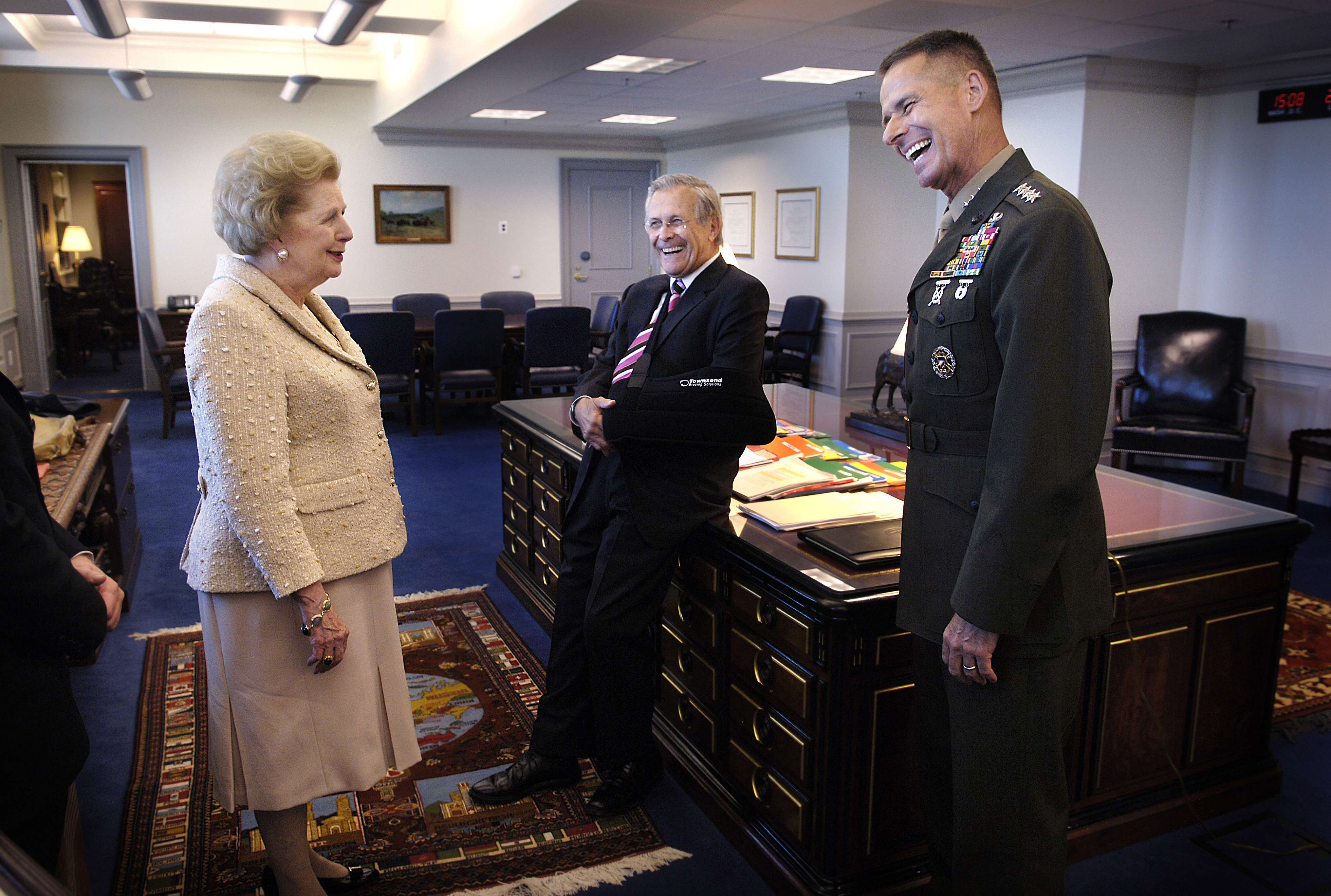
In early 2006, eight retired U.S. and NATO-member generals and admirals publicly called for Rumsfeld's resignation in what became known as the "Generals' Revolt," accusing him of "abysmal" military planning and a lack of strategic competence. Commentator Pat Buchanan reported that Washington Post columnist David Ignatius, who often traveled to Iraq and supported the war, indicated these generals "mirror the views of 75 percent of the officers in the field, and probably more." Rumsfeld dismissed these criticisms, stating, "out of thousands and thousands of admirals and generals, if every time two or three people disagreed we changed the secretary of defense of the United States, it would be like a merry-go-round." President Bush consistently defended Rumsfeld, stating that he was "exactly what is needed."
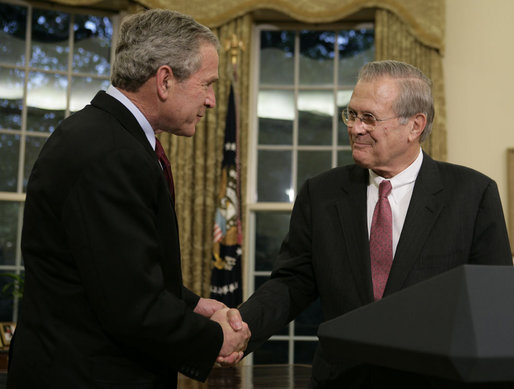
On November 1, 2006, Bush stated he would stand by Rumsfeld as defense secretary for the remainder of his term. However, Rumsfeld had written a resignation letter dated November 6, 2006, which President Bush saw on Election Day, November 7, 2006. Following the elections, which saw a shift to Democratic control in both the House and Senate, Bush announced Rumsfeld's resignation on November 8, 2006. Many Republicans expressed dissatisfaction with the timing, believing that knowledge of Rumsfeld's impending resignation could have altered voter behavior.
Bush nominated Robert Gates to succeed Rumsfeld. On December 15, 2006, a farewell ceremony, including an armed forces full honor review and a 19-gun salute, was held at the Pentagon Mall Terrace in honor of the departing Secretary.
6. Retirement and later life (2006-2021)
After his departure from government, Donald Rumsfeld remained active in various public and private endeavors, including writing and establishing a foundation.
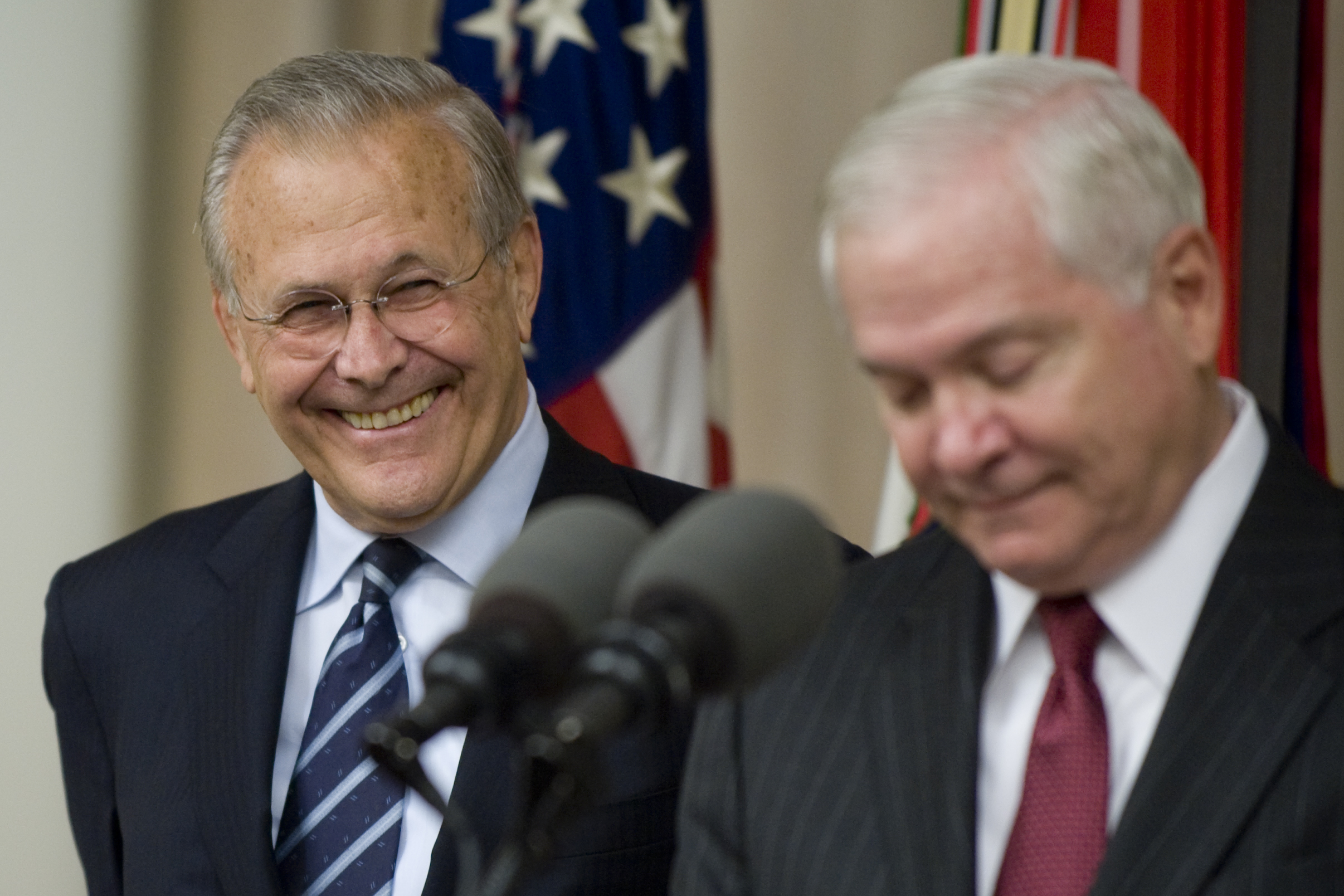
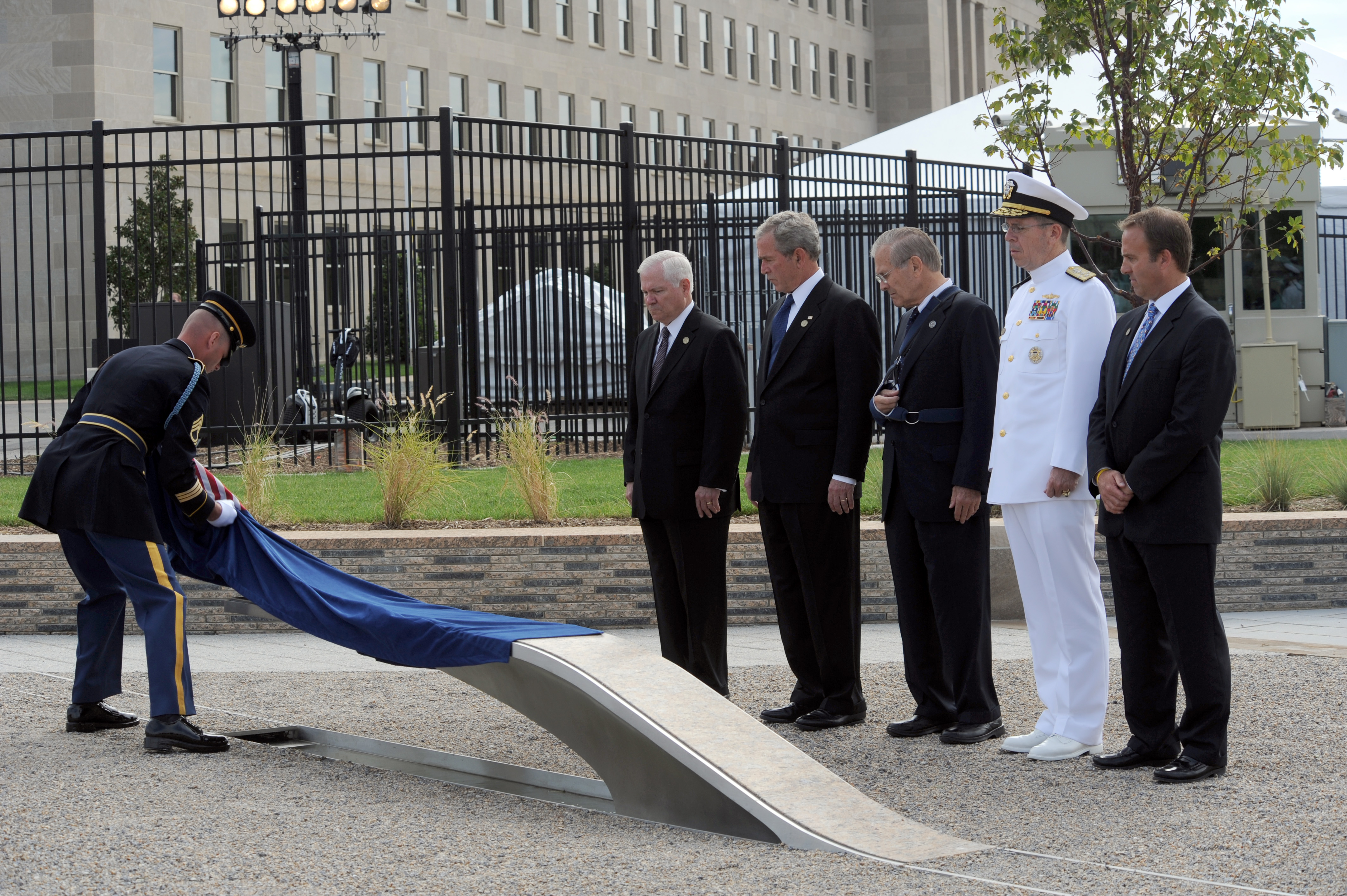
In the months following his resignation, Rumsfeld engaged with New York City publishing houses to discuss a potential memoir. After receiving significant bids, he reached an agreement with Penguin Group to publish the book under its Sentinel HC imprint. Rumsfeld declined an advance for his memoir and stated that all proceeds would be donated to veterans' groups. His book, titled Known and Unknown: A Memoir, was released on February 8, 2011.
Coinciding with the book's publication, Rumsfeld launched "The Rumsfeld Papers," a website providing documents related to the book's endnotes and his service in the George W. Bush administration. The website was later expanded to include over 4,000 documents from his archive, covering his congressional voting record, the Nixon administration, memos and documents from his time in the Ford, Reagan, and George W. Bush administrations, private sector documents, and NATO documents.
In 2007, Rumsfeld established The Rumsfeld Foundation, which aims to encourage public service in the United States and support the development of free political and economic systems abroad. The foundation provides fellowships to talented individuals from the private sector interested in government service. Rumsfeld personally financed the foundation. As of January 2014, the foundation had sponsored over 90 fellows from Central Asia, provided over 1 million in tuition and stipend support for graduate students, awarded over 2 million in microfinance grants, and donated over 3 million to charities for veterans' affairs.
Rumsfeld was awarded the "Defender of the Constitution Award" at the 2011 Conservative Political Action Conference in Washington, D.C., on February 10, 2011. He also published Rumsfeld's Rules: Leadership Lessons in Business, Politics, War, and Life in 2013, and When the Center Held: Gerald Ford and the Rescue of the American Presidency in 2018.
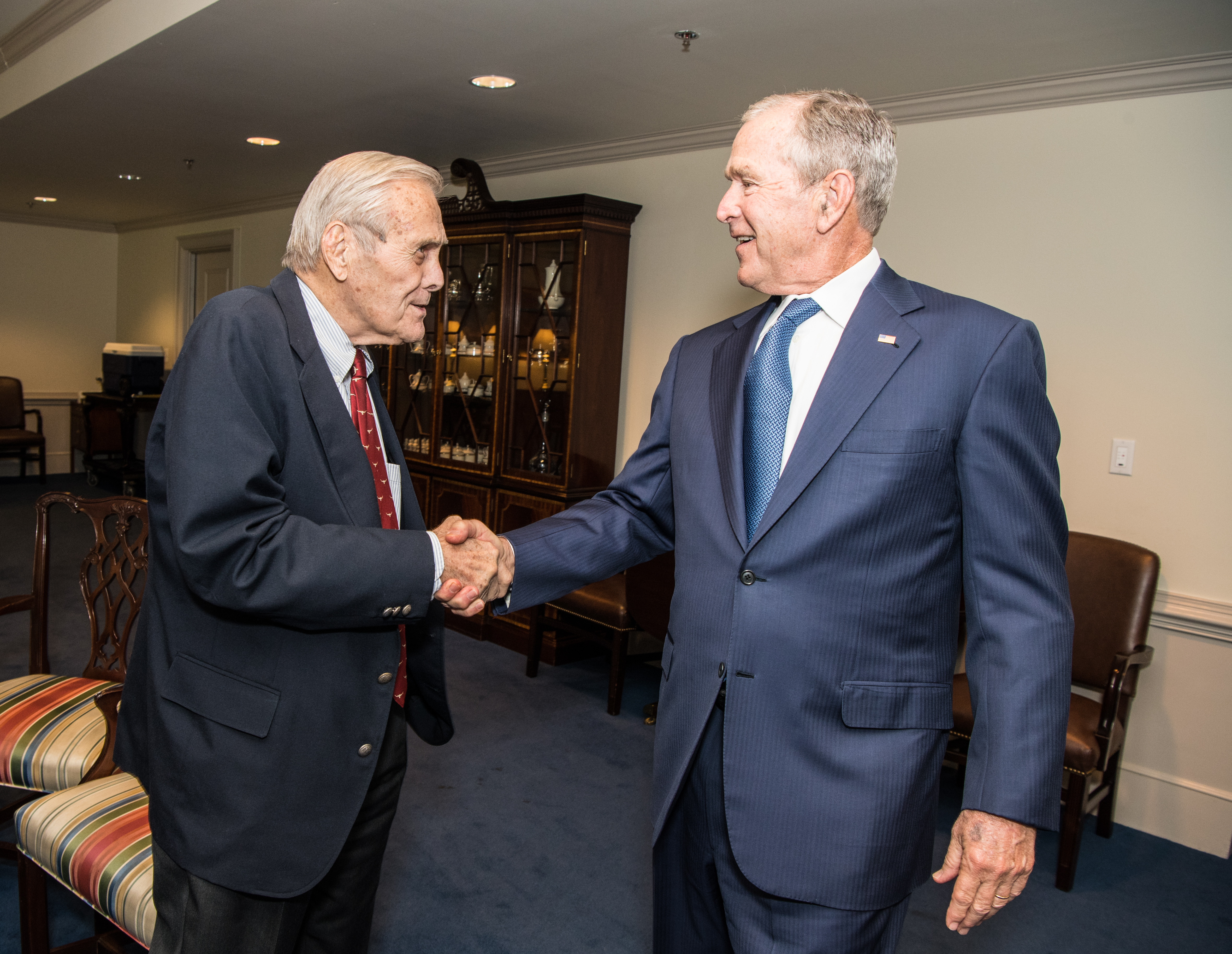
6.1. Views and statements
After his retirement, Rumsfeld openly criticized former fellow Cabinet member Condoleezza Rice, then Secretary of State, in his memoir, asserting that she was fundamentally unfit for office. Rice responded in 2011, stating that Rumsfeld "doesn't know what he's talking about. The reader may imagine what can be correct about the conflicted matter."
In February 2011, Rumsfeld endorsed the repeal of the military's "Don't ask, don't tell" policy, stating that allowing gays and lesbians to serve openly was "an idea whose time has come." In March 2011, he commented on the 2011 military intervention in Libya, telling ABC News Senior White House Correspondent Jake Tapper that the Obama administration should "recognize the mission has to determine the coalition. The coalition ought not determine the mission." Rumsfeld used the word "confusion" six times to describe the United Nations-backed military effort.
In October 2011, Rumsfeld conducted an interview with Al Jazeera's Washington, D.C., bureau chief Abderrahim Foukara. Foukara questioned Rumsfeld about whether the Bush administration had sent enough troops into Iraq to secure the country's borders and whether that made the United States culpable for the deaths of innocent Iraqis. Foukara claimed that Pentagon sources had told Rumsfeld the number of troops sent into Iraq was insufficient. Rumsfeld denied this, stating, "You keep making assertions which are fundamentally false. No one in the Pentagon said they were not enough." As Foukara pressed him repeatedly, Rumsfeld asked, "Do you want to yell or do you want to have an interview?" He called Foukara's questions "pejorative" and accused him of "not being respectful" and "just talking over, and over, and over again."
Rumsfeld was the subject of the 2013 Errol Morris documentary The Unknown Known, whose title references his famous "known knowns" response at a February 2002 press conference. In the film, Rumsfeld discusses his career from his congressional days in the 1960s to planning the invasion of Iraq in 2003.
In January 2016, in partnership with the literary and creative agency Javelin, Rumsfeld released Churchill Solitaire, a mobile app game based on a variant of solitaire played by Winston Churchill. Rumsfeld and the Churchill family stated that profits from the game would be donated to charity. In June 2016, Rumsfeld announced his intention to vote for Donald Trump in the 2016 presidential election.
On January 5, 2021, Rumsfeld was one of ten living former Secretaries of Defense who co-signed a letter warning President Trump against involving the military in any dispute regarding the 2020 presidential election results.
7. Death
On June 29, 2021, Donald Rumsfeld died from multiple myeloma at his home in Taos, New Mexico. He was 88 years old. Following a private funeral at Fort Myer, he was buried in Arlington National Cemetery on August 24, 2021.
8. Legacy and reception
Donald Rumsfeld's historical legacy and the public's reception of his career are multifaceted, marked by both praise for his leadership and significant criticism for his policies and management, particularly during the Iraq War.
8.1. Overall evaluation
Rumsfeld's public service had a profound impact on defense policy and military transformation, shaping U.S. foreign and military affairs for decades. He was recognized for his efficiency and efforts to modernize the defense system.
8.2. Positive reception
Rumsfeld received accolades for his leadership style and his perceived ability to drive efficiency and modernization within the defense system. Henry Kissinger, a former bureaucratic rival, complimented him as "a special Washington phenomenon: the skilled full-time politician-bureaucrat in whom ambition, ability, and substance fuse seamlessly." His proponents often lauded his decisive leadership and his commitment to military reform, particularly the development of a more agile and technologically advanced force.
8.3. Criticism and controversies
Rumsfeld's career, particularly his second term as Secretary of Defense, was marked by significant criticism and numerous controversies. Henry Kissinger described him as "the most ruthless man" he knew. George Packer of The Atlantic labeled Rumsfeld "the worst secretary of defense in American history," criticizing his inability to change his mind. Bradley Graham, a Washington Post reporter and author of By His Own Rules: The Ambitions, Successes, and Ultimate Failures of Donald Rumsfeld, noted that Rumsfeld "left office as one of the most controversial Defense Secretaries since Robert McNamara and widely criticized for his management of the Iraq war and for his difficult relationships with Congress, administration colleagues, and military officers."
Neoconservative commentator Bill Kristol criticized Rumsfeld for having "breezily dodged responsibility" for planning mistakes in the Iraq War, specifically citing insufficient troop levels. In Destiny and Power: The American Odyssey of George Herbert Walker Bush (2015), the 41st president, George H.W. Bush, was highly critical of Rumsfeld, calling him "an arrogant fellow" who "served the president badly" and stating, "I don't like what he did, and I think it hurt the president having his iron-ass view of everything."
Major criticisms also focused on the accuracy of intelligence regarding Iraq's weapons of mass destruction, allegations of intelligence manipulation, and his accountability for detainee abuse scandals like Abu Ghraib. His management style was frequently described as confrontational, leading to reported conflicts with political colleagues and military leaders.
9. Publications
Donald Rumsfeld authored several notable books and reports throughout his career:
- Strategic Imperatives in East Asia, (Heritage Foundation, 1998)
- Rumsfeld's Rules: Collected Wisdom for a Good Life (Free Press, 2002)
- Known and Unknown: A Memoir, (Sentinel HC, 2011)
- When the Center Held: Gerald Ford and the Rescue of the American Presidency (Free Press, 2018)
10. Awards and honors
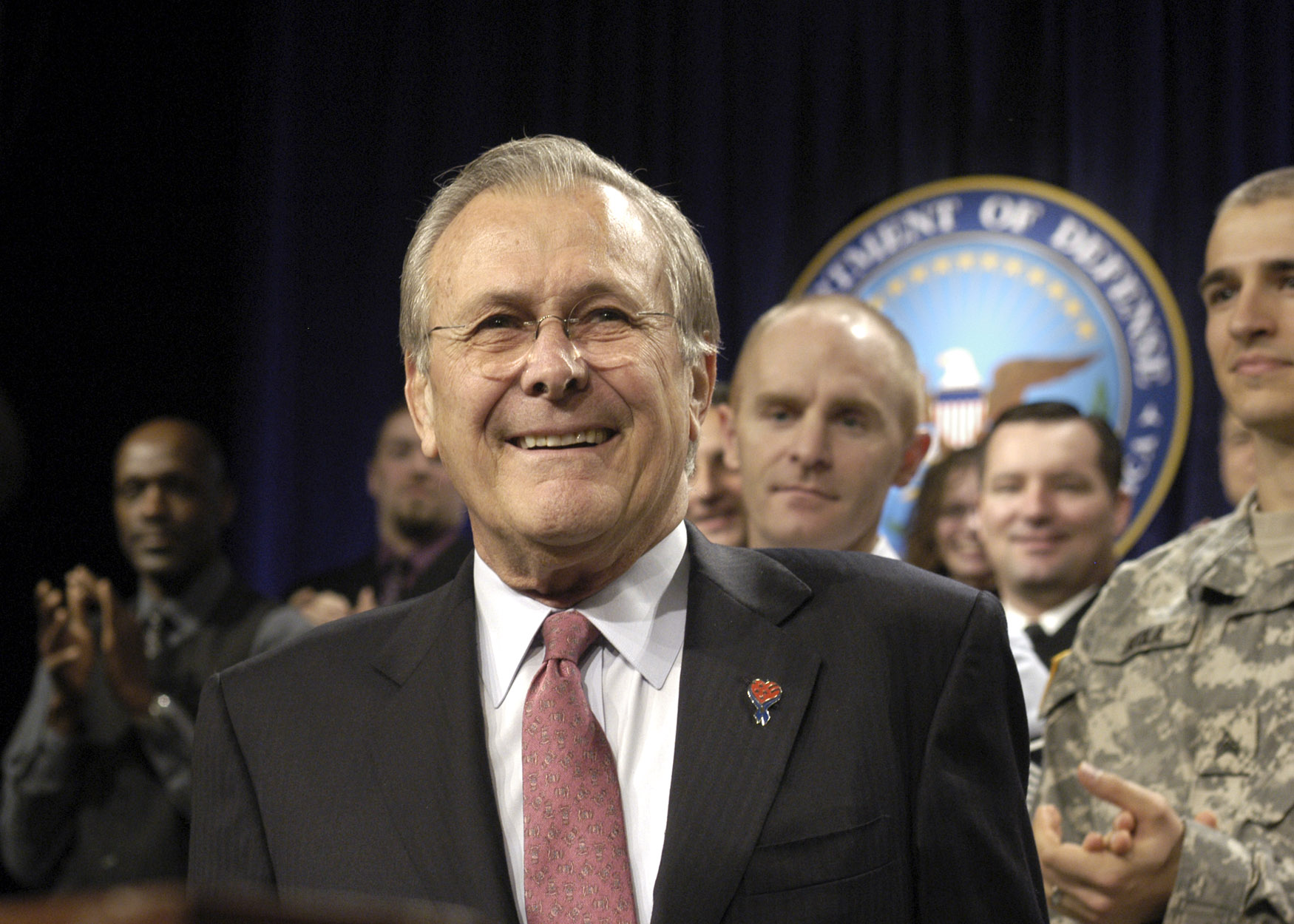
Rumsfeld received 11 honorary degrees. Following his years as CEO, president, and chairman of G. D. Searle & Company, he was recognized as Outstanding CEO in the pharmaceutical industry by The Wall Street Transcript (1980) and Financial World (1981).
Some of his other awards and honors included:
- All Navy Wrestling Champion (1956)
- Golden Plate Award of the American Academy of Achievement (1983)
- George C. Marshall Medal by the Association of the U.S. Army (1984)
- Woodrow Wilson Medal by Princeton University (1985)
- Dwight D. Eisenhower Medal (1993)
- Lone Sailor Award by the U.S. Navy Memorial Foundation (2002)
- Statesmanship Award by the United States Association of Former Members of Congress (2003)
- Ronald Reagan Freedom Award (2003)
- James H. Doolittle Award by the Hudson Institute (2003)
- Gerald R. Ford Medal presented by President Ford and the Ford Foundation (2004)
- Distinguished Eagle Scout Award by the Boy Scouts of America (1976)
- Golden Raspberry Award for Worst Supporting Actor (2004) for his appearance in Fahrenheit 9/11
- Union League of Philadelphia Gold Medal for Citizenship (2006)
- Claremont Institute Statesmanship Award (2007)
- Victory of Freedom Award from the Richard Nixon Foundation (2010)
- Order of Anthony Wayne from Valley Forge Military Academy
- National Flag award from Albania's President Bujar Nishani (2013)
His international honors included:
| Ribbon | Country | Honour | Year |
|---|---|---|---|
 | United States | Presidential Medal of Freedom | 1977 |
 | Japan | Grand Cordon of the Order of the Rising Sun | 2015 |
 | Saudi Arabia | Grand Cordon of the Order of King Abdulaziz | 2002 |
 | Poland | Grand Cross of the Order of Merit of the Republic of Poland | 2005 |
 | Romania | Grand Officer of the Order of the Star of Romania | 2004 |
 | Rwanda | Medal of the Royal Order of the Lion | 2007 |
 | Taiwan | Grand Cordon of the Order of Brilliant Star | 2011 |
11. Electoral history
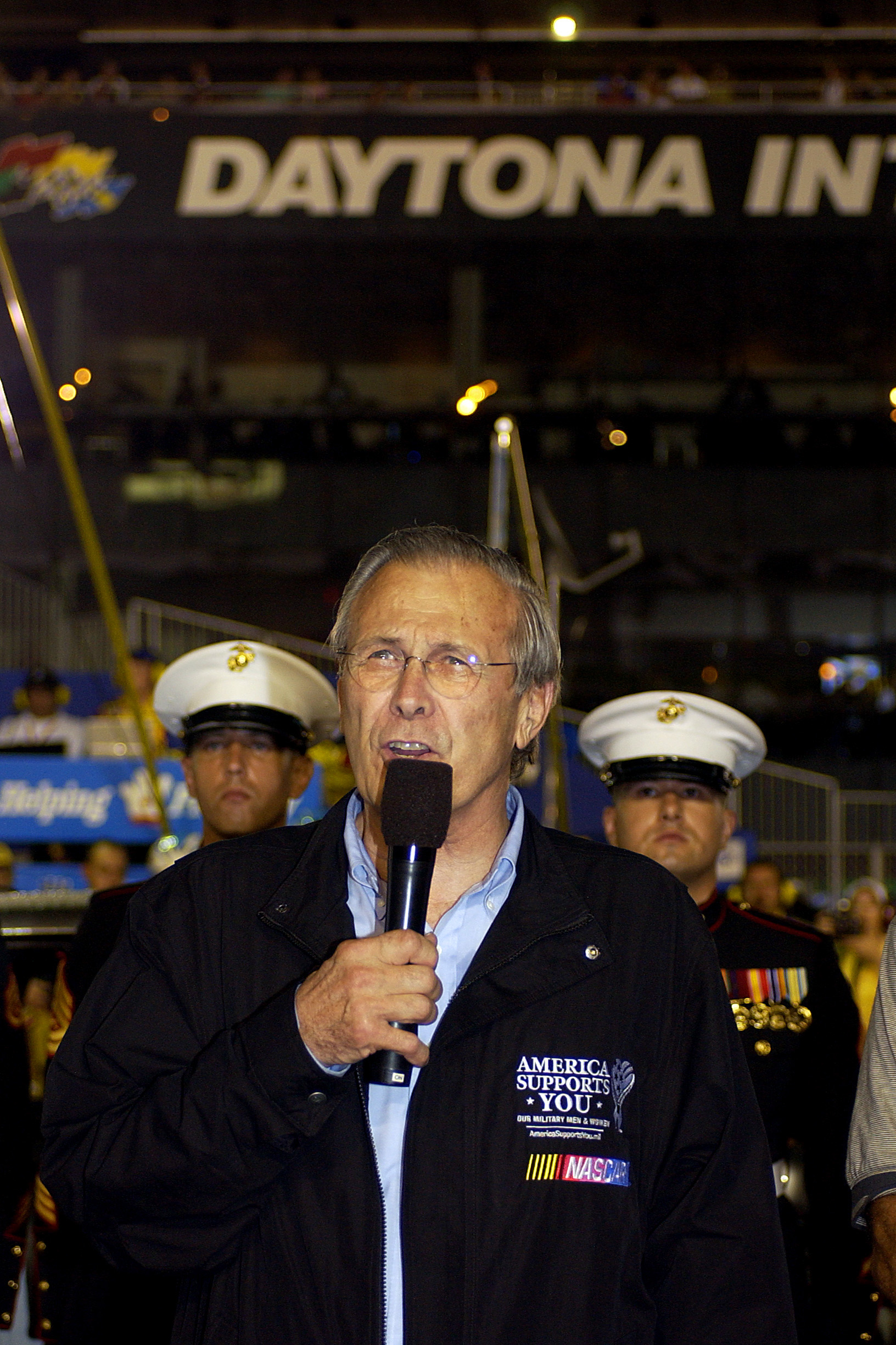
During his four successful campaigns to represent Illinois's 13th congressional district in the U.S. House of Representatives, Rumsfeld consistently won by significant margins. His share of the popular vote ranged from 58% in 1964 to 76% in 1966. In both 1975 and 2001, he was overwhelmingly confirmed by the United States Senate after being nominated by presidents Gerald Ford and George W. Bush, respectively, to serve as U.S. Secretary of Defense.
The following table summarizes the results of key elections in which he participated:
| Election Name | Office Name | Term | Party | Vote Percentage | Votes Cast | Result | Outcome |
|---|---|---|---|---|---|---|---|
| 1962 Election | Representative (Illinois' 13th District) | 88th | Republican | 63.52% | 139,230 | 1st | Won |
| 1964 Election | Representative (Illinois' 13th District) | 89th | Republican | 57.82% | 165,129 | 1st | Won |
| 1966 Election | Representative (Illinois' 13th District) | 90th | Republican | 76.01% | 158,769 | 1st | Won |
| 1968 Election | Representative (Illinois' 13th District) | 91st | Republican | 72.74% | 186,714 | 1st | Won |
12. Organizational affiliations
Donald Rumsfeld held numerous affiliations across institutional, governmental, and corporate sectors throughout his career.
12.1. Institutional affiliations
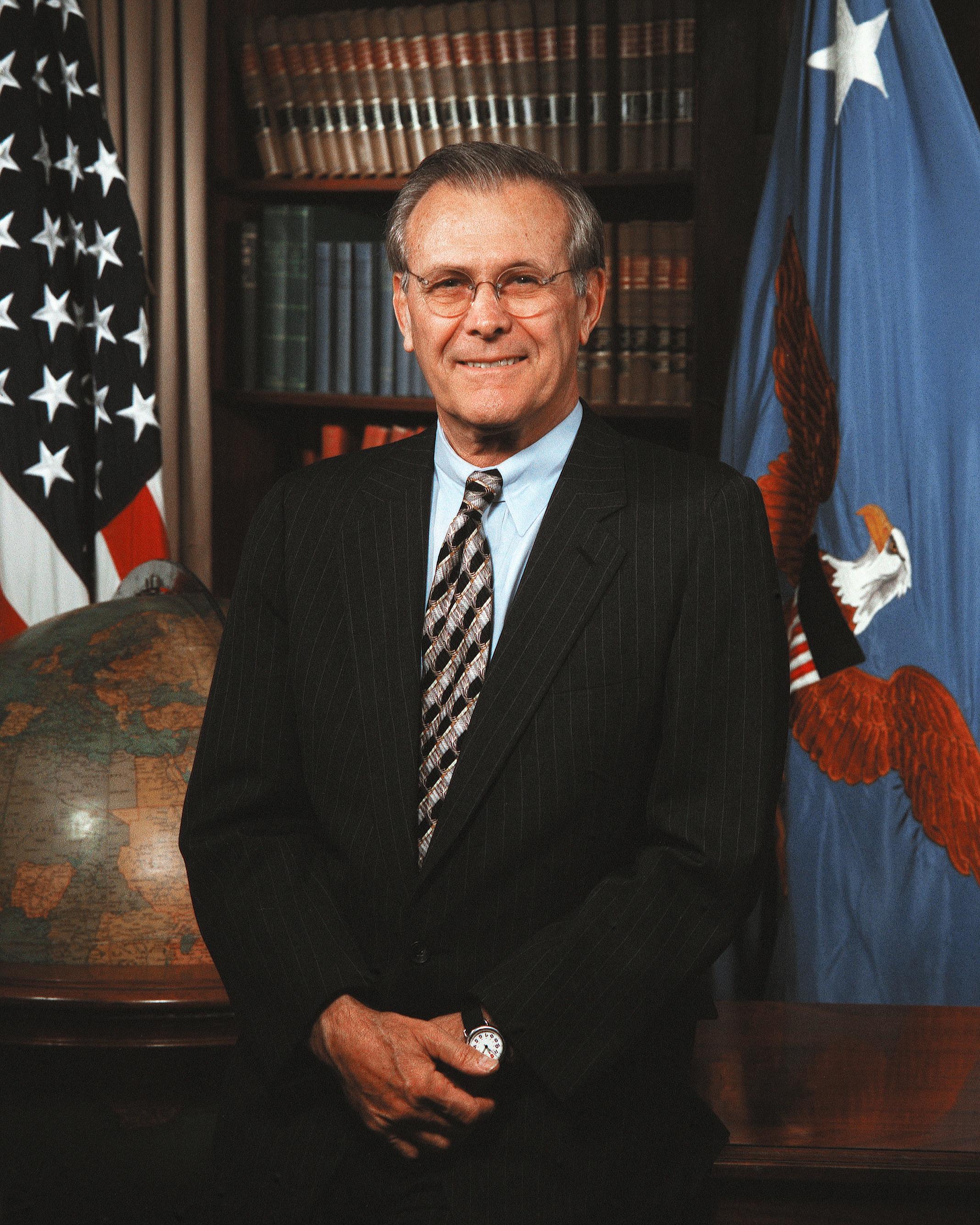
- Center for Security Policy: Longtime associate and winner of the CSP's 1998 "Keeper of the Flame" award.
- Hoover Institution: Former member, board of trustees.
- Project for the New American Century: Signed PNAC's founding statement of principles and two policy letters on Iraq.
- Freedom House: Former board member.
- RAND Corporation: Former chairman of the board from 1981 to 1986 and from 1995 to 1996.
- Committee for the Free World: Former chairman.
- National Park Foundation: Former member.
- Eisenhower Exchange Fellowships: Former chairman.
- Le Cercle: Member.
- Bohemian Club: Member.
- Alfalfa Club: Member.
- National Academy of Public Administration: Member.
12.2. Government posts, panels, and commissions
- Secretary of Defense (2001-2006)
- U.S. Commission to Assess National Security Space Management and Organization: Chairman (2000)
- U.S. Trade Deficit Reviews Commission: Member (1999-2000)
- Commission to Assess the Ballistic Missile Threat to the United States: Chairman (1998)
- National Commission on Public Service: Member (1987-1990)
- National Economic Commission: Member (1988-1989)
- President Reagan's General Advisory Committee on Arms Control: Member (1982-1986)
- U.S. Joint Advisory Commission on U.S./Japan Relations: Member (1983-1984)
- Presidential Envoy to the Middle East, Reagan administration (1983-1984)
- Presidential Envoy on the Law of the Sea Treaty, Reagan administration (1982-1983)
- Secretary of Defense (1975-1977)
- White House Chief of Staff in Ford administration (1974-1975)
- U.S. Ambassador to NATO (1973-1974)
- U.S. Congress: Representative from Illinois (1962-1969)
- United States Navy: Various posts, including aviator (1954-1957); reserves (1957-1975); retired as a Navy captain (1989)
12.3. Corporate connections and business interests
- Eastern Air Lines: Former director.
- Gilead Sciences: Joined as a director in 1988, chairman (1997-2001).
- General Instrument: Chairman and CEO (1990-1993).
- G. D. Searle & Company: CEO, chairman, and president (1977-1985).
- Gulfstream Aerospace: Director.
- Tribune Company: Director.
- Metricom: Director.
- Sears: Director.
- ABB: Director.
- Kellogg's: Director from 1985 to 1999, during which time Carlos Gutierrez was president, CEO, and chairman of Kellogg's until his appointment as Secretary of Commerce under Bush in 2005.
- Amylin Pharmaceuticals: Director.
13. See also
- There are known knowns
- Rumsfeld Doctrine
- Known and Unknown: A Memoir
